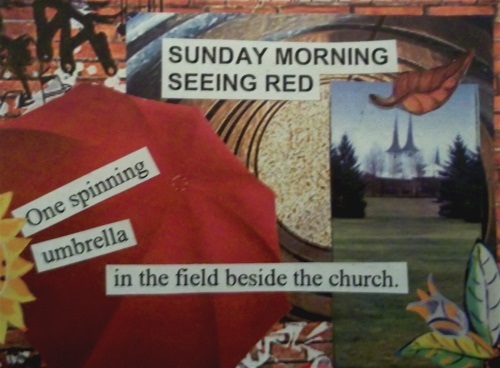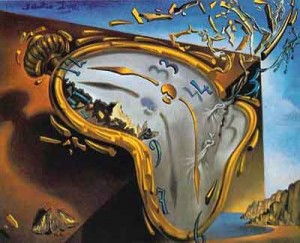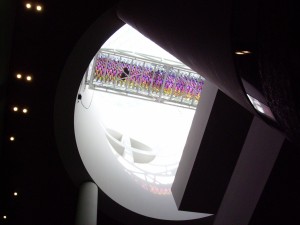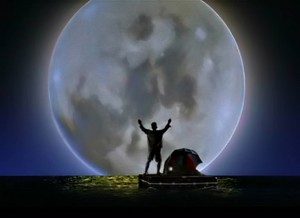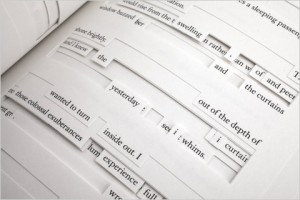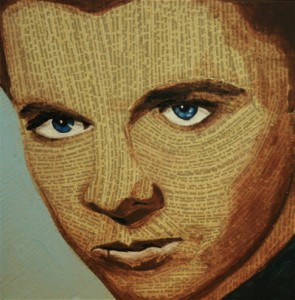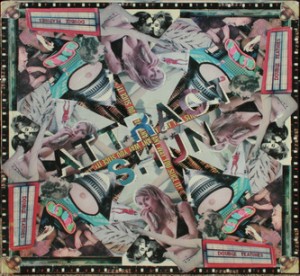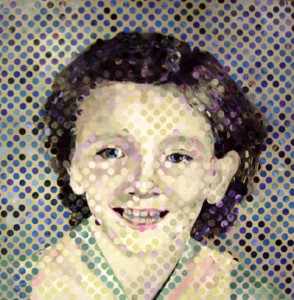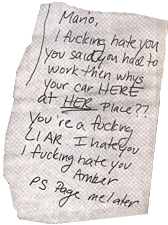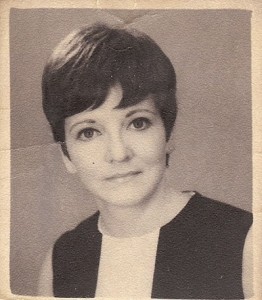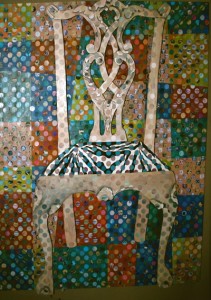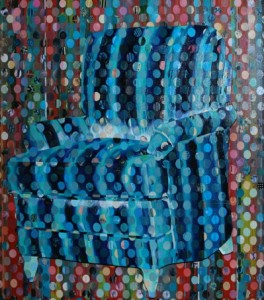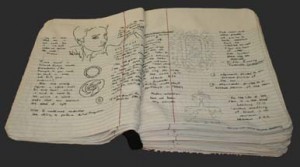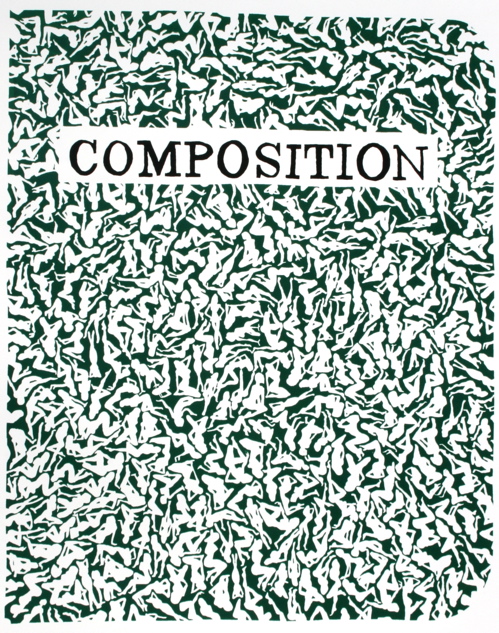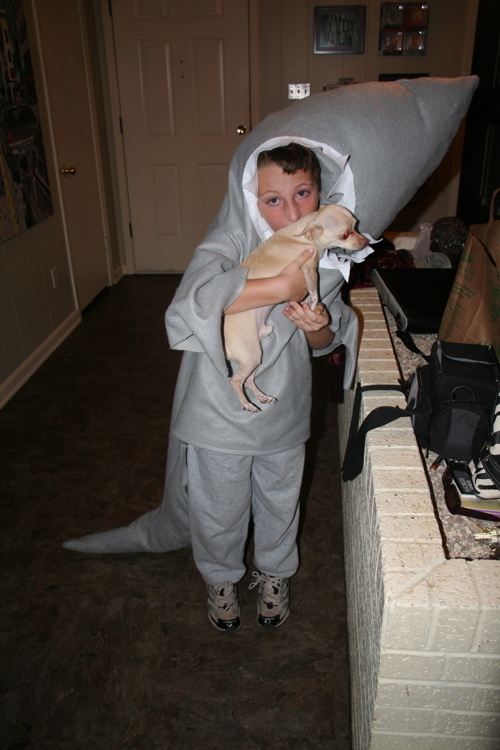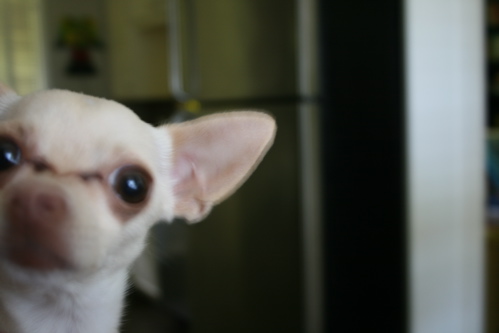Cheryl Hicks
APW Poet Blog
February, 2012 (Archived)
Cheryl Hicks
Cheryl Hicks is a writer, artist and teacher living and working in East Texas. Her work has been published extensively in the United States and abroad. Some of the publications include: Borderlands: Texas Poetry Review, Crate, Halfway Down the Stairs, Toward the Light, Shakespeare’s Monkey Review, and Other Poetry.
She is a previous recipient of the Paddock Poetry Award and presented poems from her series titled Conversations with the Virgin at the 2006 Rocky Mountain Modern Language Association Conference in Tucson, Arizona. Hicks’s art has been shown across Texas and in New York, and her collages have appeared in several magazines and journals. Most recently her portraits were featured in Missive, Atticus Review, Blue Print Review, and Granny Smith. Her mixed media work was featured at the Fort Worth Contemporary in July 2008.
Hicks is currently working on a series which combines her love of words and art. It is titled “I Just Don’t Read Like I Used To,” and is created by cutting books into strips of text and collaging them to create an image. Hicks’ self portrait is an example of this technique.
Monday, February 6, 2012.
(To contact Cheryl Hicks, write to her at chickswords (at) gmail (dot) com
AN INTRODUCTION
First, a few words to introduce myself. I have been teaching Creative Writing, Journalism, English, Art, and several other subjects to high school students for twenty years, and I am looking forward to retiring in a few months. I wanted to do this blog for the month of February because I am always looking for ways to make myself write.
One would think that the simpler the writing task is, the easier it would be to dive right in. But I have discovered that, at least for me, it helps to have guidelines. For example, I periodically scan through the listings on Duotrope to find journals or magazines that are looking for specific types of poems or stories. I once came across a journal titled Route 66 in which every entry was exactly 66 words. (Before you get excited and start editing your stories and poems to fit, let me warn you that this mag is now defunct.) I never submitted anything here, but I played with a couple of stories I had written and discovered that a writer really can tell a story in 66 words. When writing such a short short, every word is important, and the title carries a lot of weight. For example:
OR WE COULD PUT TINFOIL ON THE WINDOWS
Mamma wasn’t listening.
“Or maybe I need one of those satin sleep masks like the movie stars wear…”
I stretched out on Mamma’s bed, corpselike, and began to snore like a stooge.
“Of course, there’s always the danger that I could forget to take it off, and wander out of my room, out of the house, into the street, and…”
“Okay!” she snapped. “Forget the nap!”
As a writer and artist, I am always playing around with ways in which the two disciplines are similar. One way artists sometimes approach a problematic subject is to turn it upside down. By doing this, the objects in the picture are not easily recognized and the artist is able to focus on the positive and negative spaces. This often results in a much more accurate drawing. So, I wondered if this upside down process could be applied to writing. Of course you can’t really turn a poem or a story upside down before you write it, but this can be an interesting editing tool. I once wrote a prose poem that just didn’t please me, so I reversed the order in which the events happened and edited it down to 66 words. (Sometimes defining the parameters of a project very precisely puts the emphasis on the action of writing instead of the final product and can help eliminate writer’s block.) This is what I came up with.
BACK ON THE SHELF
Raindrops reconfigured and lurched toward the clouds. Modern poetry leapt from the parking lot’s neatly end-stopped, asphalt spaces back into Clara’s bag as the lengthy rip mended itself like a closing zipper. Her car doors locked and she shouldered backwards through the double doors of the bookstore where the bored clerk accurately returned her money.
Seeing Sam so unexpectedly was crushing.
Clara systematically reshelved the books.
Not the best writing I have ever produced, but both pieces taught me something about the writing process.
Tuesday, February 7, 2012
A PSEUDO-SCIENTIFIC APPROACH
Sometimes we just need a kick-start to get our minds revved up. One exercise I have my creative writing students do every day is to write every word they can think of in 60 seconds. They are always surprised at some of the words that pop into their lists and how their lists grow a bit longer each day. The interesting thing, of course, is that there is some type of connection between each word, so this list then becomes a natural resource, an armature on which the writer may flesh out something larger.
I find a lot of ideas and inspiration in science, too. Several years ago I wrote an entire series of “pseudo-scientific” love poems and titled it Falling Bodies. Here is an example:
GEODE
Ours is a natural history;
if shattered
our spectacular reactions
would glow.
My body knows instinctively
how you love me.
Every stone knows your hands,
how they think
about my waist.
Every wash knows the taste
of our kiss, open mouthed,
and the heat sweetly channeled
when your thumbs
trace the twin indentations
at the base of my spine.
One more time, try to say
our love is a loose tooth,
hesitation a pale dream.
Out of time,
we are a hollow song
grinding ourselves
against perfect rhyme.
Today is Sunday
and the sun has just set.
I say you can’t hide
when a colorless moon
paints a hole in the sky.
I’ve known moisture,
I’ve known heat,
I’ve known radiating truth.
Break me open–
I’ll break you.
We are all filled with crystals.
I ended up with over 60 poems in this series. From time to time when I am truly blocked, I still pull out a copy of Scientific American for inspiration! The best thing about a series is that it encourages the writer to take a concept and twist it in many different directions.
My students also enjoy a site called Language is a Virus. It offers a variety of playful text generators and manipulators. Now, I don’t think it is a valid practice to simply cut and paste text into a generator and call the product a poem. But such a practice almost always results in at least an intriguing phrase or pairing of words or ideas. This site also has a long list of good writing prompts and practices. For example, it suggests that a writer structure a poem or prose writing according to city streets, miles, walks or drives. Perhaps take a fourteen-block walk, writing one line per block to create a sonnet. Or choose a city street familiar to you, walk it, make notes and use them to create a work.
I combined this idea with an assignment I gave my students: “Go on a walk and look for things that are red.” This was the result.
SUNDAY MORNING, SEEING RED
Unfurled red umbrella
in the field beside the church.
Full blown, due east.
No Entrance. Full metal tunnel
on the playground.
Metal inside. Metal out. Blue.
No Parking.
Do Not
Enter.
Green acorns underfoot.
Yellow plywood. Golden ripe wood.
Blue graffiti on brown brick.
Buried Cable: Before Digging
Call This Number.
Number the cars. Number the
Taillights. taillight. taillight.
Diesel odor, taillight, taillight. Trailing
one vibrant oblong leaf in the puddle near the
school. One car going too fast,
one “STOP!” showering splash.
One spinning
umbrella
in the field beside the church.
Full open. Facing south.
No Entrance.
No Parking.
No end.
*******
Even though I was actively looking for the color red, what I noted was how all the other colors played against the reds. And then, of course, the implications of religiosity, acceptance, and even technology crept into the poem.
I hope you will try some of these exercises and share them. Until tomorrow…
Wednesday, February 8, 2012
FLIPPIN’ OUT
Yesterday I began reading Yann Martel’s Beatrice and Virgil. It begins with a discussion by Henry, a fictional author, of his latest book, which consists of two parts, one a novel and the other a piece of nonfiction, an essay. Martel writes, “The book Henry wrote was in two parts, and he intended them to be published in what the publishing trade calls a flip book: that is, a book with two sets of distinct pages that are attached to a common spine upside down and back-to-back to each other.” (6) This is not to be confused with the kind of flip book that is “a novelty item, a small book with a series of slightly changed images or photographs on succeeding pages;
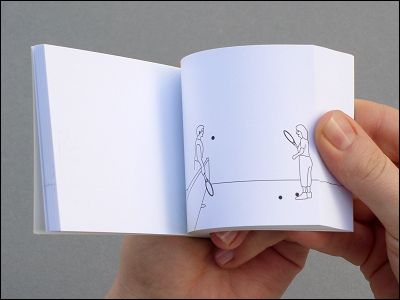
when the pages are flicked quickly, the illusion of animation is created, of a horse galloping and jumping, for example.” (9) Martel explains, “A flip book is a book with two front doors, but no exit.” (6)
This idea of a book that approaches the same subject from two different directions, like a tunnel, made me think of one of the poems I posted yesterday, “Sunday Morning Seeing Red.” I have been working with my AP students on doing close readings of poems, and our discussion lead us to the question of whether poets are always aware of the symbols and archetypes they utilize in their poems. We had been using an online dream dictionary to quickly look up symbols in poems, so I decided to approach my own poem in that same way. The resulting self/poem analysis, which follows below, was a sort of flip book piece of prose that formed a counterpart to the original poem.
I went walking last Sunday. Having a hard time writing, a hard time thinking, I set out on a self-prescribed assignment to look for red things—points of departure that would hopefully lead me on a path toward clarity. I was drawn to an open red umbrella, powerful and dignified, in the flat area beside the First Christian Church. The wind was tossing it about a little, but mostly it faced East, true as a compass, shielding nothing as the sun was hidden by clouds and haze. Beside the field, there was a drive near the church with a NO ENTRANCE sign. This struck me as ironic, yet based on my relationship with organized religion, somehow appropriate.
Even though my original intent was to take note of red objects, my perverse (a.k.a. poetic) nature led my eye to the blue tunnel in the playground. It seemed more welcoming, more innocent, more of a sanctuary than the church. I pondered for a moment the nature of the perfectly cylindrical passageway—both entrance and exit, somehow comforting as it limited one’s perspective. My gaze proceeded about the area only to land on more signs prohibiting parking and entering.
I kept walking. My path was paved with the satisfying crunch of acorns, small and sacred, unrealized trees. Green, yellow, blue—acorns, plywood, bricks–nature was surely being overcome by technology. Graffiti gave way to the perfect printing on signs that warned against digging too deeply. (Heaven forbid, no pun intended.)
I counted cars. More accurately, I counted taillights. And if I scrunched my eyes almost closed, the passing lights became a swirling solar system of red stars, not as perfectly drawn as those found on flags, but just as ideological. I noted the tangy diesel odor that remained behind some of the vehicles and was drawn to a singular leaf in the puddle that separated the church from the school. I had been filled with conflict when I started out today, but the walk, the umbrella, the leaf—they all combined suddenly without the need for words and brought a small smile to my face. Even the splash of a car going by much too close and much too fast became just a splash, not an attack.
My thoughts returned to the crimson umbrella. Still open, it had shifted momentarily from East to South—from chasing enlightenment to naturally questioning everything. I continued on my walk, progressing from one red flash to the next. My brain could not rest, and I knew the path would go on forever.
(I have included below some notes from the dream dictionary site: hyperdictionary (dot) com. If I were technologically advanced enough, I would have added an electronic flip book with a red umbrella spinning across the bottom of the page… Alas, I can only leave you with the image.)
Umbrella: an emblem of power and dignity; an umbrella indicates a shield against your feelings.
Field: Seeing green fields in your dream, symbolizes great abundance, freedom, and happiness. You may also be going through a period of personal growth. Alternatively, this dream may simply be an expression for your love of nature. Seeing freshly plowed fields in your dream means growth, early rise to wealth and fortunate advancements to places of honor. Seeing dead or barren fields means lack, pessimism and your jaded prospects for the future.
Church: Seeing the outside of the church in your dream means sacredness and spiritual nourishment. It is representative of your value system and the things you hold sacred. Dreaming that you are in a church, suggests that you are seeking for some spiritual enlightenment and guidance. You are looking to be uplifted in some way. Perhaps you have made some mistakes in the past which have set you back on your path toward your goals. With proper support, you will get on the right track again. Alternatively, it may also mean that you are questioning and debating your life path and where it is leading. You are reevaluating what you want to do.
East: heading east represents inner wisdom and spiritual enlightenment. You need to devote or dedicate yourself to your goals, family, career, etc. The direction east also symbolizes the sun. Since east is related to the direction right, it can suggest that you are headed in the right direction.
Metal: means strength and character. It may also symbolize the inhumane side of society. Seeing a tunnel in your dream, represents the womb and birth. Thus it may refer to a need for security and nurturance. Dreaming that you are going through a tunnel, suggests that you are exploring aspects of your unconscious. You are opening yourself to a brand new awareness. Alternatively, it indicates your limited perspective. Seeing the light at the end of a tunnel, symbolizes hope.
Acorn: Dreaming of acorns means that you will be meeting with success in your professional life. All your hard work and sacrifices paved the way to this success. You might have started small, humble and modest, but you will be getting a big share of the wealth pie. Emotionally, you grew to be a stable, motivated, strong willed individual, who can make a difference not only in his life, but also in the life of others.
Wood: Dreaming of wood, suggests that you are feeling dead inside and emotionless. You may be behaving automatically and just going along with the flow. Or you may be acting out without fully thinking things through. Dreaming that you are carving or shaping a piece of wood indicates a power-giving, creative act/gesture. Alternatively, the wood may also symbolize spirituality and vital energy.
Color: Colors in dreams represent energy, emotions, and vibes. First consider what that single color in your dream means to you and your own personal associations and relationship with that color.
Blue: Blue is the color of the Virgin Mary, and is associated with purity. In addition, it is the color of water and the sea, with all the symbolic references already discussed for that element – that is, blue usually indicates femininity, life, purity, etc., just as water does. Blue can also symbolize peace, calm, stability, security, loyalty, sky, water, cold, technology, and depression.
Yellow: Yellow can symbolize joy, happiness, optimism, idealism, gold, dishonesty, cowardice, deceit, illness, and hazard.
Red: Red can symbolize many things; from blood, to love, to infatuation. Basically red symbolizes strong emotions, or things of strong emotions rather than intellectual ideas. For example, red can symbolize excitement, energy, speed, strength, danger, passion, and aggression.
Green: Green can represent nature, the environment, good luck, youth, vigor, jealousy, envy, and misfortune.
Brick: represents your individual ideas and thoughts. Experience and/or heartbreak may have hardened you. Building a brick wall means a wall that you are putting up to protect yourself against hurt. It may also indicate that you may be hard on the outside but still sensitive on the inside.
Digging: means that you are working too hard in trying to uncover the truth in a problem that is haunting you. You may also be preoccupied with trying to find out about yourself , your reputation, and your self-identity. Dreaming that you dig a hole and find something shiny means a favorable turn in your fortune. Dreaming that you dig a hole and fill it with water indicates that no matter how hard you try, your efforts will not make things go your way.
Leaves: Seeing leaves in your dream means new found happiness and an improvement in various aspects of your life. It is symbolic of growth and openness. Seeing brown or withered leaves in your dream means fallen hopes, despair, and loss.
Car: Dreaming that you are almost hit by a car, suggests that your lifestyle, beliefs or goals may be in conflict with another’s. It may also be symbolic of a jolting experience or injured pride.
South: Dreaming of the direction south indicates life, expectations, and questions. Alternatively, it may symbolize love, passion and warmth. Or it is an indication that a plan has gone awry.
Thursday, February 9, 2012
EARTH FRIENDLY
Many years ago I received a letter from a friend of mine, Ruth, and she had made the envelope out of a page from a magazine. Because I am a fan of recycling, and admittedly love to make things from magazines, I stole her idea (with her encouragement), and though, in this electronic age, I don’t write as many letters as I used to, I still make what I have come to refer to as “Earth Envelopes” when I do send snail mail. Over the years, my envelopes have become increasingly more complex and decorative. If you would like me to make you an envelope and mail you the instructions to start making your own, just send me your name and address. You can email it to me at chickswords (at) gmail (dot) com. Ruth passed away several years ago, and I like to think that her habit of recycling magazine pages into small works of mail art lives on in this way.
I am fascinated with the idea of mail art. Artstampnews (dot) com promotes mail art as a way for artists to stay creative and to also meet others with a similar interest. According to this site, mail art is an alternative to ”the elitist and exclusionary rules of art projects which employ judges who select entries based upon the whims of the few; mail art welcomes the participation of nearly anyone who would like to create and share the results of their efforts with others.” I like the inclusivity implied in this statement. I like thinking that at any given moment, the postal system, worldwide is facilitating artists in the delivery of their small works!
Another art form which is similar in its approach is the Artist Trading Card. I first became acquainted with this art form when one of my students suggested that my creative writing and photography classes collaborate on a trading card exchange. For those who are not familiar with ATCs, they are small works of art which are about the size of a baseball card (2 ½ x3 ½ inches). They can be made of any material, using any technique, and are usually traded, not sold. For three years, when I had a studio space large enough to host a hundred or so ATC makers, I held an annual trading card exchange for my students and several art students in the area. The way this works is that each artist brings his or her cards, usually showcased in the plastic pages designed to house baseball cards, and they trade with the other artists. Sometimes this is a one to one trade; sometimes, especially if a card is really popular and highly valued by the traders, the ratio may be skewed. ATC traders at such an event always want to be the one who has the card everyone is trying to get! If you would like access to thousands of examples of ATCs, just go to www (dot) artist-trading-cards (dot) ch (forward slash) gallery (dot) html, and click on any of the names on the right hand side of the page. The variety and creativity are astounding! If, after viewing the examples, you wish to become a trader, you can find all kinds of themed entry calls online.
As an artist, photographer and writer, I enjoy being able to combine my interests on ATCs and other forms of mail art. Here is an ATC based on my poem.
Friday, February 10, 2012
DREAM WORK
“In my dream I’m floating,” he said. “And you know that fluttery feeling you get in your stomach when you float? It’s like that… and I’m over a valley, floating about as high as the surrounding mountains. There is a house in the valley with a porch all around it, and Crystal, B.J. and Pappy are on the porch… and they’re all smiling and motioning for me to come toward them. I want to go to them, but I feel myself struggling, as though I’m being pulled backward by a powerful force. And I know… somehow I know that Death is coming for me. And it’s not that I’m afraid, I just can’t let go… But then I finally do. I stop struggling… and they smile at me from the porch… then I’m free. I realize I have to let go in order to be free… I have to leave behind the things I love to be free.”
And did hearing his dream upset you?
Yes. Yes it did.
Why? Because it was about death?
No. I don’t think so. It was more that I thought he was confused. I don’t think Death was pulling him from behind. I think it was luring him toward the house. I think he barely escaped. But I don’t know. He said, while he had been floating, he drifted closer to Crystal, was drawn to her, and that at first he thought she was wearing braces on her teeth, which she never had. Then as he got closer, he saw a brilliant gold light emanating from her mouth. He said it was the most beautiful thing he had ever seen. Maybe that’s why he struggled to stay. I asked him about it years later, and he looked at me very intently, a little confused, and he said, “I don’t really remember it any more…”
*******
The passage above is from a piece of creative nonfiction titled “Other People’s Dreams” I had published a few years ago in a journal called Halfway Down the Stairs. In the essay, I discuss the burden other people place on you when they insist on relating their dreams. Dreams are often a source of inspiration for writers and often the theme around which magazines or journals are organized. Such was the case with the issue of Halfway Down the Stairs in which my work appeared. Yesterday I ran across another journal, an anthology titled The Way We Sleep, which is devoted to beds and sleeping.
I have been forcing myself to submit my work for publication more aggressively lately. So with the dream theme in mind, I took a look at my poetry to determine how many were sleep related. I was astounded to discover that out of approximately 60 poems that I have not had published, 23 of them had at least a passing reference to dreams. Here is an example:
LILY DOWN
I have had this dream
several times now
in one form or another,
several times since Dot died,
wherein we are talking
and she keeps telling me
there is someone there
with her. She keeps trying
to give the phone
to some woman named Lily.
Then I hear the hollow clatter
of the swinging, dropped receiver.
Never any real communication.
And I wake up with my tongue pressed hard
against my teeth, checking
for the first signs of looseness.
*******
I think one appeal of the dream poem is the built-in mystery. Another element is the way dreams can seep from sleep into our waking lives. The following poem is an example of this.
GRIMALKIN’S MAGIC
So, you came to me last night
in a strange dream with a strange cat.
One of you, with your smooth mouth
and pale eyes, with just the slightest hesitation,
gentled me, repeatedly.
One of you
settled
in a curl of heat around my shoulders
so deliberately.
There was a garden
and it seems
you played a
banjo…
The song remains.
*******
Lately I have been having some crazy dreams. I keep having a recurring dream in which I have invented a new online search engine. And even though technology is a huge part of my life, I certainly am not wired in such a way that I could accomplish such a feat. I guess I will just have to wait for the dream to play itself out or reveal its mystery to me.
Saturday, February 11,2012
ON SECOND THOUGHT
Having come across a journal, Ink Monkey Press: Stories of You Anthology, which only accepts pieces written in second person point of view, I have been thinking a lot today about that particular approach. Over the past few years I have written over 100 love poems to a mysterious, unnamed “you.” Today I asked myself “why?” Was this simply a way to explore a fictional relationship? Or perhaps there is a deeper psychological motivation at work here. Maybe what I was really doing was exercising my desire to completely control a situation. I say this because I realize how one-sided a second person point of view is. It leaves no room within the text for “you” to respond. Consider the following prose poem for example.
BUYING TIME
Pointing northwest and northeast, all new timepiece hands are set at ten past ten. (An intentionally supplicating posture based on market research, subliminal message, and the appealing gesture of the raised hands.) In a life filled with such trivial manipulation, some days I am tempted to identify, classify and name all of my demons.
Some days you save me. You push against me as gently as a breeze. As surely as the blood thrum that accompanies a potent brew, you coax from me incantations, bright sounds springing from the same root as birdsong, and through mystical language, I am bound to be set free.
When I was a victim of self-forgery, you compelled me to see I could never have been born under the hands of another. When I lost my feathers, you offered music and opened my ears. If I could have brought forth, one by one, all the fish in the sea, I would not have found the magic salmon on my own.
In small tribute, I lift my hands–I touch your mouth–for to dive into such honey, is to be born into sweetness, pure sunlight again & again.
*******
The poem starts out with an informative style, and in the second stanza shifts to a more personal tone when it addresses a seemingly specific “you.” The irony here, I see now, is that the poem is really all about “me.” I think also that this may be perceived by the reader as self-centeredness and that it places an undesirable barrier between the writer and the reader.
It’s funny where ideas for poems originate. This poem was inspired by the fact that in all advertisements for watches, the time is almost always set at 10 past 10.  I discovered this one day when cutting up magazines for my artwork. (This discovery made me hyper aware of how many things go on around me about which I am totally oblivious!) A 2008 article in the New York Times titled, “Why Time Stands Still for Watchmakers,” discusses the reasoning behind staging watches this way for purposes of photographing them. One watch company executive said, “Because brand names generally are centered on the upper half of a watch, hands positioned at 10 and 2 frame the brand and logo.” Evidently, the watch face is also perceived to look more like a smiley face when the hands are uplifted in this way. (Strangely enough, digital watches are usually set at 10:10, too.) The Times article also revealed that the time on iPhones is almost always set at 9:42 when they are captured in ads. The theory behind this is that it was at 9:42 Pacific Time when Steve Jobs introduced the iPhone at a conference in 2007.
I discovered this one day when cutting up magazines for my artwork. (This discovery made me hyper aware of how many things go on around me about which I am totally oblivious!) A 2008 article in the New York Times titled, “Why Time Stands Still for Watchmakers,” discusses the reasoning behind staging watches this way for purposes of photographing them. One watch company executive said, “Because brand names generally are centered on the upper half of a watch, hands positioned at 10 and 2 frame the brand and logo.” Evidently, the watch face is also perceived to look more like a smiley face when the hands are uplifted in this way. (Strangely enough, digital watches are usually set at 10:10, too.) The Times article also revealed that the time on iPhones is almost always set at 9:42 when they are captured in ads. The theory behind this is that it was at 9:42 Pacific Time when Steve Jobs introduced the iPhone at a conference in 2007.
Here is another poem inspired by a bit of trivia. According to Xperi-Mania, Post-It Notes were discovered in 1970 when a chemist was trying to develop super strong glue. Instead of succeeding in this pursuit, he accidently made an adhesive that wasn’t very sticky. A couple of years later, a colleague came up with the brilliant idea to apply the glue to small pieces of paper to use as bookmarks that would stay in place but lift off without damaging the pages. This poem, you will notice, also is in second person.
MORE THAN CORDUROY
So, maybe you were right,
you know, about corduroy,
about it not being accidental,
not like post-it notes, assumptions and electricity,
and about how the push-pull
of such a two-way fuzziness
could come between two people
with so little surface tension.
And maybe you were right,
you know, about this other thing—
this escalating dance,
this shattered calm, and how,
more than corduroy,
it makes my fingers move
in trancelike patterns,
makes me bite my lip, and giggle,
and cry. And maybe you just knew
how a simple touch could make me believe
in the unimaginable softness
of blind faith.
*******
And obviously I am not the only one who has been inspired by Post-It Notes!
Sunday, February 12, 2012
ANTICIPATING THE FALL
I am spending a quiet day today just thinking about what life will be like when I don’t work every day. One day earlier this week, my AP English IV class and I were conducting a close reading of “The Love Song of J. Alfred Prufrock. When we came to the line, “I have measured out my life with coffee spoons,” I connected with it in a way I never have before. I have been teaching for about 20 years now, and worked in a variety of jobs for many years before I started working in education. Even though I have time off in the summers, I sometimes feel as though my time has been accounted for by an outside source. I am sure most people feel this way. But teachers especially spend their weekdays living bell to bell, so to speak, and a lot of their so-called “free” time is spent on planning and grading and on extracurricular activities.
I don’t know if I am just getting old or impatient, but more and more the past couple of years I have grown to resent the way I am forced to spend my time. For one thing, my students today don’t appreciate my time as much as my students did a few years ago. I find that my relationship with my students is strained, lacking a real emotional connection. And so I have decided to stop teaching. I am not nearly old enough to retire, but I am smart enough to quit.
And I have been spending quite a bit of time thinking about how I will spend my time. As with most things in life, time is defined by how one perceives it. Time can drag by when life is stressful, such as when a teacher has a digital stack of instructional “modules” to view before she can get down to the even less enjoyable task of proctoring a state-mandated test. Or time can speed by when the sun is shining, the air is crisp, the laundry is done, the house is clean, and I have nothing more important to do than walk across town just because I haven’t walked across town lately.
I am reminded that the world around me changes very little from day to day. I, on the other hand, find myself in a constant state of flux. I am reminded that all around me art is waiting to be found. A few years ago, I read about a movement that took place in the 60s, the Fluxus movement in art. According to an article in Wikipedia, “Fluxus artists preferred to work with whatever materials were at hand, and either created their own work or collaborated in the creation process with their colleagues.” Performance art, found art, and multi-media events are just a few concepts that sprang from this movement.
One of the most famous pieces of found art is Marcel Duchamp’s Fountain,
which is, of course, actually a urinal. What makes it art is that he “designated” it as such and placed it in a context as art. Duchamp coined the term “ready made” to describe such found art. Trash art, junk art, assemblage, and of course, collage, are all forms of found art.
The more I ponder it, the more I have decided that it comes most naturally to me to think of life as found art. When I was cleaning my breakfast nook this morning, I didn’t plan to rearrange the furniture and place a series of before unrelated yellow bottles on the table with a backdrop of sheer gold fabric draped across the window. But there was just something about the quality of light and the way it was slanting across the floor that made me take a moment to re-evaluate the small space. When I was folding the towels, fresh from the dryer, I didn’t plan to stack the browns and golds and reds on the dressing room counter, but once they were there, I saw no reason to hide them in the bathroom cabinet.
I am not an interior decorator, a house stager, or even a very finicky person, but I do know when I stumble upon a small artistic moment. In a few minutes, I am going to cook lunch and organize my art studio. Then I am going to spend the remainder of the day working on a commission piece. It is a large mixed media piece that refers to Botticelli’s Birth of Venus, which, I was pleased to discover, was to a certain extent, a re-creation of a painting by Apelles, a fourth century Greek painter. The easily recognized face in my painting is set, however, not against a natural backdrop, but against a cityscape, which is comprised of over 12,000 small images.
The model’s hair is more vivid, and the lighting offers more contrast. But like the original Venus, my version is meant to be read on multiple levels.
Botticelli’s Venus has been interpreted as using the beauty of the female form to draw the viewer in, employing art appreciation as a gateway into exploring more intellectual and spiritual pursuits.
My Venus is not nude and she is not rising from a seashell. In fact, she is visible only from the neck up. She is a modern woman and a thinker. She is taking in information and making decisions. She is imagining her life and discovering it in a way that is artful and open. Perhaps I will call her Venus Surmising.
The notion that the discovery of life in small bits is an art form in itself is not a new one for me. A few years ago I wrote a love poem titled, “Designated Ready Maid.” On one level it is a pun inspired by the found art of Duchamp. On another plane it is a poem that recognizes how every small thing we come across colors the way we spend our time, and the relationships in which we are involved. Everyone is left with the decision: Is life a urinal or a fountain. I will close with my poem.
DESIGNATED READY MAID
I would take the thickness of an eager kiss,
take my heart’s crankshaft clatter
and the narrow width of that brilliant flare
that flashes between day and night,
take the texture of a smooth bright
red pencil on a blue-lined yellow pad,
to make satisfaction,
pour it into a Styrofoam cup
and drink it up
just as cool.
I would measure your mouth,
define immeasurable quantities,
like enough and too much,
and paint that fascinating fullness
in between.
I would write of want,
and recognition of want,
of all the steps from touch to bend,
through each retreat
to the surging delight
that repeatedly drifts to the side
like snow packed on the toe of a booted foot
slipping through and through and through
picking up frozen residue on the run.
And I would not run.
I would lie to give you that full feeling,
as heavy and sure as a pink hydrangea,
as insistent as a swinging noose,
but without distrust,
without aggression,
without that yellow pulling back.
These parted lips, this shallow breath,
this effortless dispersal toward the gullet—
beneath this wanting
lies the secret of desire
perfected by its lack of rules.
Monday, February 13, 2012
TO SLEEP, PERCHANCE TO DREAM
“Some nights I almost die in my sleep. I keep the muzzle pointed at my head, and though tentatively I am tethered by bed sheets and promises of the good life, my saving grace is reality… and knowing that the end is only a figure of speech.”
*******
The passage above is from a piece of creative nonfiction I wrote a few years ago titled, “A Sudden Willingness to Sleep,” published in Families: The Frontline of Pluralism. It is about my own battle with insomnia.
Even at a young age, I had trouble sleeping–trouble going to sleep, and trouble staying asleep. As I got older the problem would become exacerbated to the point that my mother would eventually take me to a sleep specialist. A few electrodes later, it was revealed that I was a “hyper” sleeper, cycling through R.E.M. sleep in half the time of the average specimen. Interestingly enough, studies have shown that it is during these periods of relatively light sleep that memories are formed. It has also been hypothesized that disruption of R.E.M. sleep can improve depression. I guess, on some instinctive level, even at an early age, I was attempting to control what my brain took in, how I stored it, and how I would deal with it later.
As I mentioned earlier in this blog, I write a lot about sleep. Maybe that is because I think of sleep as a haven, an escape. Maybe this perspective is part of the reason sleep alludes me. In the poem below I connect sleep to all the seemingly meaningless images and activities that make up a typical day. The poem also connects seething irritability with unsatisfactory sleep.
AROUND THE MOUNTAIN
AT THE END OF A SLEEP
you seem to think
you are as beautiful
as the sun
filtering
slanted through the trees
that you
distract me
like those beams
and drive me
headlong without regard
into traffic coming on
last Saturday
I cleaned the kitchen drawers
spent the drizzly morning
bent on trying to remember
into which clattery pullout
I had stashed my dreams
if I seem to be
invulnerable, you
are sorely misinformed
*******
I used to tell myself that I would sleep if and when I got tired enough, but lately I have seen a lot of research that indicates that sleep deprivation can lead to a multitude of physical ailments—everything from colds and flu to heart disease and diabetes. So, it is possible then that sleep has actual curative powers.
I have always associated mystical, magical properties with sleep. For example, I am a big believer in the powers of the lucid dream, a dream in which you realize you are dreaming. This allows for conversations with dream characters, problem solving, and magical adventures.
Many people report having clear insights on the cusp between sleep and wakefulness. For example Salvador Dali is said to have created several of his iconic paintings through the inspiration of his sleeping visions. He supposedly would take a nap while holding a spoon, knowing that when he reached an altered state of consciousness, he would drop the spoon and waken himself in time to remember whatever he had been dreaming about.
The image above is a detail from the painting by Dali titled “Persistence of Memory.” (Note that the time is not set at 10:10.) The poem below discusses the irony of the sleeper being unable to function fully during this half-awake phase, and yet having enhanced mental clarity.
AS THOUGH SUFFERING
FROM BROCA’S APHASIA
Most mornings about five a.m. I hear the roar,
the bump, then the backing up of the truck
that dumps the trash across the street,
and I rehash the resolutions
I have made since yesterday’s hearing.
Half-awake I call to you as all around us
bodies fall deliberately through the dark
hoping to be cushioned by another’s surprise.
I imagine their collective shadows
as their dives are choreographed, practiced,
perfected, while figuratively linked by the mystery
of reproduction, as they strive for divinity,
speaking clearly without words.
Because I cannot say, I stumble through the day
trying not to take sacred images at face value,
and I strain to remember, when
as gloriously plentiful and as unavoidably blurred
as night bugs smeared on glass, their messages
were most clear in that sharp intake of breath
just moments before I was severed from my wings.
Words fail us. Systems fail us,
but whether we hear it or not, music always plays,
and where straight line meets curve,
energy gathers, bringing tension, seeking release.
Soundlessly bound by our golden connections,
we fruitlessly examine each link of the chain.
So hungry for the comfort of noise, we need
its endless stream of illusion, its irreverent burn,
its edgeless dream of grace and its inevitable sequels.
Tuesday, February 14, 2012
I’M NOT GONNA WRITE YOU A LOVE SONG
I know, it is Valentine’s Day, so I should probably post a sentimental love poem. But I am really pretty pragmatic about the whole romantic love thing. Don’t get me wrong—I admire people who can maintain a long-term committed relationship, and I admire loyalty and respect at any level. But it has been my experience that most relationships are the result of proximity and a desperate desire not to be alone. The poem below, one of the few I have written for the juvenile market, considers how children are taught, even in fairy tales, that they are not complete until they hook up.
BLUE BLOOD
Tree frog on the back door screen,
strangest frog I’ve ever seen—
the back porch light seeps through your skin
illuminating life within.
Aortic arches filter light
against the backdrop of the night,
while renal arches branching, curve
like thin blue fingers through tangled nerves.
Your tiny pumping heart shines through
and your life-blood surges, clear and blue.
Translucent Blue Blood, tell me true,
could you be my prince?
********
As a teacher, it often feels as though educators are expected to teach much more than core subjects and elective content. We also teach ethics, sex education, and parenting. We teach students how to balance a checkbook, how to collaborate, how to communicate, and how to integrate. We actively encourage them to be punctual, honest and creative. But we don’t teach them the value of spending time alone.
The Valentine message I would send to each of my students is that they should learn to value themselves and care for themselves, not as the object of anyone else’s affection, but because they don’t really have anything to offer anyone else until they love themselves. Since I don’t sleep much at night, these are things I think about a lot. The poem below, titled “Vespertine” (meaning something that unfolds at night), expresses these thoughts in verse form.
VESPERTINE
When the nights are long
with their razor-sharp teeth,
the trick is knowing
which hardware is a lie.
I eliminate the expense of circumstance
by not believing
in untested harmonic accord,
the plastic interpretation of intelligence,
or that whole heartstring thing.
I believe in fullness,
the strum of life,
and staying connected
to the source.
I believe in the fire of insight
and the need to be in the spotlight
as I rise out of my dark, perfect self,
enormous and with a cutting edge.
Life and death, baby!
That’s the magic of divine song.
*******
I will close today with a daydream of sleep, another poem written to the child in each of us.
TAKIN’ THE RED-EYE
The boy with dreams of flannel wings
has his arms spread open wide
as he glides into the night dark sky
on a silent, seamless ride.
His attitude controlled by none,
unfettered and alive,
with fingertips curled slightly,
he twists his wrists to dive.
The dreamscape far beneath him spreads;
a sun-stitched quilt unfolds
with corduroy cotton fields
and pastures trimmed in gold.
Inset with streams of satin blue
and tiny dotted sheep,
the down-filled comfort’ checks his fall
and holds him while he sleeps.
Wednesday, February 15, 2012
THE LIGHT AT THE END OF THE TUNNEL
I caught a lot of flak for my post yesterday. I didn’t realize how controversial and even sad it was not to be a romantic! So, let me reassure you that I have a wonderful husband with whom I am very much in love and to whom I have been married for 37 years.(Actually, that is not true. He is wonderful and I do love him, but we have only been married 34 years. It is a sort of inside joke with us to say that we have been married 37 years, because several years ago someone asked how long we had been married, and we have been together so long that we sometimes forget how many years–so we always just say 37 years. The funny thing is that now we have been married almost 37 years!) So, I have set the record straight.
I have been thinking lately about how in both art and literature the juxtaposition of opposites creates tension. This quality is often referred to as chiaroscuro, the placing side by side of light and shadow. Of course, the extended examples are endless: depression and optimism, affluence and poverty, sweet and sour, and so on… Such focus on extremes is often the basis for humor, too. Consider the following quote by Muhammad Ali: “I’m so fast that last night I turned off the light switch in my hotel room and was in bed before the room was dark.” His words paint a vivid mental picture and get his point across in a way that is memorable.
The motif of light and dark is, of course, also used to make more serious points throughout the history of philosophy. Plato says, “We can easily forgive a child who is afraid of the dark; the real tragedy of life is when men are afraid of the light.”
Warren Buffet uses opposites to create irony when he says, “Chains of habit are too light to be felt until they are too heavy to be broken.”
It is through such juxtaposition and analysis of the resulting tension that we come to conclusions. In terms of writing, I try to explain to my students this approach as thesis, antithesis and resolution. They are beginning to grasp the concept and also to understand why the human brain craves such a series of three to feel satisfied.
In my own writing, I have discovered that I rely on this pattern quite heavily. The following poem was inspired by a meditation that was prescribed to me by a friend which was supposed to help treat a frozen shoulder.
SEATED MEDITATION
you have taught me
to sit strictly
with my arms
rotated
turned against
pain and pain and pain
until I have learned
there is no strain
the body
cannot
withstand
then when the vibrations begin
I push pain aside
pain aside with a burst
till the flower unfolds toward night
till I am darkness on the
left and pale shade on the right
I am right then
right there
right next to that edge
right next to the leftovers
cold squash in the Tupperware
then the door shuts
and the lights
go
off
*******
The meditation worked, by the way, and freed up my stiff joints.
During a trip to San Francisco in 2006, I was struck by the side-by-side existence of homelessness and affluence. This beautiful city, rich with culture and art, has also been referred to as the “homeless capital of the United States.” While I was staying there, attending a conference on Pop Culture, it was my habit to go jogging around the block on which my hotel was situated. I discovered in a rather alarming way, however, that within less than a block of my hotel, if I went in the “wrong” direction, I was soon having to leap over the bodies of homeless people on the sidewalk. If, on the other hand, I went in the opposite direction, my progress was impeded by long lines of patrons waiting to get into the Museum of Modern Art.
(The inclusion of a round skylight on the roof of the modern structure of the museum breaks up the severe, straight lines of the building and creates a fabulous chiaroscuro when viewed from inside.)
Such contrast is often the basis of architectural and artistic design. Take for example the Rothko Chapel in Houston. The chapel website explains its mission as inspiring people to “action through art and contemplation, to nurture reverence for the highest aspirations of humanity, and to provide a forum to explore matters of worldwide concern.” This official site goes on to explain that the unique chapel was founded by Houston philanthropists John and Dominique de Menil, was dedicated in 1971 as “an intimate sanctuary available to people of every belief.
A tranquil meditative environment inspired by the mural canvases of Russian born American painter Mark Rothko (1903-1970), the Chapel welcomes over 60,000 visitors each year, people of every faith and from all parts of the world. On the plaza, Barnett Newman’s majestic sculpture,
Broken Obelisk,stands in memory of Dr. Martin Luther King, Jr.” (I wrote a poem ten years ago that was inspired by a trip to the chapel, and I would include it here, but I can’t find it. Such a loss of work is, however, perhaps a topic for another day.)
I have received some excellent written responses from my students to prompts based on opposites. For example, they always come up with good poems when presented with the idea of writing a list beginning with the phrase “I remember…,” then at a point in their free writing, I interrupt them and tell them to switch to “I don’t remember…” Their initial response is, “How can I write about something I don’t remember?” Within moments they realize, however, that this can be a powerful tool for triggering memories. The poem below is one I wrote using this tool.
HOW TO GO ABOUT UNDERSTANDING
WITHOUT STEPPING ON IT DIRECTLY
(previously published in Autumn Sky Poetry and Haggard and Halloo)
I remember developing breasts,
(it was the same year the Russians launched Sputnik)
and going with my aunt to buy my first fully-trained bra,
and learning from the lady at Tots-to-Teens
how important it would be someday
to bend over at the waist when I put it on
and the first time I bent over.
I remember learning that there were men in the world
who wanted to teach me about the men in the world,
and how the faint strong smell of bleach
tinted my sheets last week after I washed the colors
with the whites and left them on the line to dry
bleeding happily all together.
I don’t remember learning I would die,
but it must have been like stepping casually
into a freshly laundered dream,
like stepping into a white tulip skirt
trimmed round the hem
with crimson quatrefoils and tears.
I wonder if I cried
and when the flowers will start to bleed.
*******
Another method of structuring a poem based on opposites is to start out in a humorous vein and then springboard into more serious topics:
ON ANGELS
TRAVELING TO THE HOMELAND
sometimes I long
to do nothing more exciting
than wear a hat,
study the tax code,
and wait for visions.
sometimes I put on my pink pants,
daring to dance around the edges
of the social scene, managing to fling myself
through life as though through
the temptation of a plate-glass door,
demanding more
than the typical shatterproof woman
has any right to.
but behind my ribs,
behind the cage of these silent bones,
I am filled with dazzling words,
vibrant, colored threads of sound.
at night I am vocal,
tying random images together,
but in the daytime I bend.
and when I contemplate the end of being,
I forget taxes,
I forget pants,
I forget words.
*******
I will close today with a provocative “light/dark” quote from American rocker David Lee Roth: “The light you see at the end of the tunnel is the front of an oncoming train.”
Thursday, February 16, 2012
FEELING SUBMISSIVE? I HAVE NO RESPONSE TO THAT.
During the past four months, I have made it a focus of my writing career to submit my work more aggressively for publication. Since the end of October, I have sent out 91 pieces of work to 27 different publishing entities. Of these, 51 are still pending, 21 have been accepted for publication, and 19 have been rejected.
Keeping up with such stats can be a daunting task. The best way I have discovered for tracking submissions is to use a data base such as http://duotrope.com. This is a tremendously valuable site that has a multitude of helpful facets. You can register (free and simply) and set up a Submission Tracker that keeps up with: title, market, date sent, date received, response, days out, and more, for each piece submitted. It also allows you to sort the data in many ways using a variety of filters. I use this to track not only my poetry and prose submissions, but also photography and artwork submissions.
Another feature of the site is that it has a search engine where you can browse over 4,000 market listings and try to find the perfect fit for your writing. Your search can be refined by applying up to 20 different options, and search settings can be saved for later use. For example, you can search for a print journal that accepts sports themed short stories of any length for use in anthologies, pays a semi-professional rate (between 1 US cent per word and 4.9 US cents per word) and royalties, accepts electronic submissions and simultaneous submissions, but not reprints.
Writers can browse market listings by title, recent updates and responses. You can also leave the search criteria wide open and just scan through the markets by fiction or poetry.
Sometimes this can lead to serendipitous discoveries that you might not stumble upon otherwise. Each market listing conveniently has a link to its website. Other features include a newsletter, a calendar of deadlines, a glossary of terms, and exhaustive information with regard to submission and publishing statistics.
The only thing missing from the site is a way to directly link it to my files! Yesterday I mentioned that I had lost one of my poems. No matter how I save, sort, print, file, and back-up my work, I still misplace things. Perhaps the best remedy to this situation I have found is to email a copy of everything to myself. That way, when a file is lost or corrupted, I can search my email and usually retrieve it. This has saved me over the years as technology has made rapid leaps from floppies to CDs to flash drives and beyond. Unfortunately, I have relied on my school email for this, and now that I am contemplating quitting my job, I am faced with the task of backing up those files to another email account.
As I face the prospect of early retirement and the myriad challenges it presents, I am simultaneously excited and apprehensive. Perhaps I just need to follow some advice from one of my favorite movies, Joe Versus the Volcano. (I know, I get teased for this a lot, but I love it!) Just after Joe Banks (Tom Hanks) and Patricia Graynamore (Meg Ryan) are married and about to jump into the volcano, she says: “Joe, nobody knows anything. We’ll take this leap and we’ll see. We’ll jump and we’ll see. That’s life.”
Today I offer you a poem, as usual. But today I chose this poem by searching my submission tracker in Duotrope. I looked for the poem that had been rejected the most times and came up with the following, rather experimental, poem which was inspired by the infinite monkey theorem in popular culture, which states that a monkey hitting keys at random on a typewriter keyboard for an infinite amount of time will almost surely type a given text, such as the complete works of William Shakespeare.
MONKEYS BY MISTAKE
So, she was
fully engaged
in this art of driving dangerously
without leverage
full speed
toward the lip
when she must have been taken by the shape
of the bug stew on the glass,
must have been trying to see through
when she went over
the bridge.
(you know, there rails
for a reason)
And the middle way
needs no shoulder, but that
means she couldn’t afford a single
shuttering blink or
brink
sink
nothing.
Not a thing but ink, maybe a little white space
and a less than feeble attempt
to make the place her wheels spun desperately
through the air… but ah, what freedom without
friction without
diction without
conviction, no confusion within.
What irony it is to rely on
animation, frame by frame,
fleshed out with subtle changes in the blanks
(no thanks to the artist…)
No, it doesn’t take a genius
to measure skid marks
to randomly write Shakespeare
to ride the lines, wasting valuable time
when THERE IS NO EDGE.
Without shoulders,
the knees must be strong.
*******
This poem has been rejected six times, but I am not quite ready to give up on it. Maybe tomorrow’s post should be on the merits of revision…
I close today with a belated Valentine to my husband—one of my favorite quotes from Joe Versus the Volcano: “I saw the moon when we were out there on the ocean, shining down on everything. I’d been miserable so long. Years of my life wasted. Been a long time coming here to meet you. A long time on a crooked road. Did I ever tell you the first time I saw you, I felt like I’d seen you before?”
It really is a good movie!
Friday, February 17, 2012
TOUCH AND GO
I had the dream gun in my dream hand last night, but the scene didn’t lend itself effectively to death. The sensation was like falling off a building and waking before making the ground my final home, and I sat up, wondering how I could have botched the landing again.
“Charlie—Lima—Bravo, thie Juliet—Alpha—Bravo…”
“Charlie—Lima—Bravo here, “ I answered matter-of-factly into my walkie-talkie.
Even though he hated being called “Juliet,” Bubba was a stickler for authenticity and insisted that we use our real initials as our call signs. And since I didn’t really mind being called “Charlie,” I didn’t argue with him about it.
“Request flight level three five zero.”
“What?!?!?”
“All you have to say is “Roger Wilco. Level three five zero approved. Over.”
“Okay.”
“Then say it!” As his exasperation reached new levels, Bubba forgot to mimic the droning tones of a seasoned pilot.
“Roger. Wilco,” I repeated tonelessly. “Level three fize zero approved. Whatever…”
*******
The passage above is from a creative nonfiction piece titled “Touch and Go” that I have come to consider a failed text–not only because it has been submitted and rejected a couple of times, but because every time I read it, I am dissatisfied with it—and yet I have not been able to fix it.
The reason I am looking at it again today is because I think I have come up with a way to revise it. You see, I have been reading a book titled, Tree of Codes, by Jonathan Safron Foer. It is the most unusual and beautiful book I have ever read. To create the book, Foer took his favorite book, Bruno Schulz’s Street of Crocodiles, and cut into it to make a new book. He literally cut away words from each page, leaving only a few words in some cases, to make a new book. Astounding.
In an interview in the New York Times earlier this week, Foer said, “It was hardly an original idea: it’s a technique that has, in different ways, been practiced for as long as there has been writing—perhaps most brilliantly by Tom Phillips in his magnum opus, “A Humument.” But I was more interested in subtracting than adding, and also in creating a book with a three-dimensional life. On the brink of the end of paper, I was attracted to the idea of a book that can’t forget it has a body.”
Brilliant.
As you will see from the photo above, the technique used to create Tree of Codes results in a tremendously textured, three dimensional book. Reading it is a visual, tactile, and intellectual experience. This type of design is referred to as ergodic, meaning literature that requires effort on the part of the reader, other than turning the pages, to traverse the text.
It is partly because of the physicality involved in the reading that made me think of my story, which is built around the idea of touch. I began to wonder then if perhaps I should cut up this, my least favorite story, in the way Foer cut up his favorite book, in an attempt to make something entirely new of it. I will get back to you when I have attempted this and share the results, or perhaps the lack of results.
This idea of cutting up books to make something new is not new to me at all. I have been working on a series of art pieces that are titled collectively, “I Just Don’t Read Like I Used To.” They are made by cutting books into strips of text and using the strips as bits of collage matter in my mixed media panels. I have included a couple of examples below: Johnny Depp as The Mad Hatter from Alice in Wonderland, and Audie Murphy as The Youth from Red Badge of Courage.
As I mentioned a couple of days ago, I have also been working on a commission piece, which is based on Botticelli’s “Venus Rising.” Yesterday I came across a book in my closet, “The Girl with the Botticelli Eyes,” and started cutting it up. My plan is to make a portrait of Venus using the strips. I like to immerse myself in similar projects this way. Then if I get tired of working on one, I can switch over to the sister project without totally losing focus.
In one way or another, most of my art is generated by me cutting up magazines or books. For example, I once ordered twelve subscriptions of Interview magazine to allow for repetition in my collages. Here is an example titled “Attract Shun.”
Another time I took issues of the same magazine and tore the pages to reveal images beneath while keeping the spines intact. I then scanned the magazines into PhotoShop and manipulated the images. I wrote passages to accompany each part and titled the nine-piece result “Ken Recalls a Rehab Romance.” I have included part five here. The accompanying text reads: “But Barbie was not content to wait for him to make the first move. Her heart sought ease. Her body burned with curiosity.” To see the entire intermedia piece, go to http://cherylhicks.weebly.com/intermedia.html
I will close today with a poem that was previously published in POEMS-FOR-ALL. This is an unusual poetry “journal,” which describes itself as follows: “They’re scattered around town — on buses, trains, cabs, in restrooms, bars, left along with the tip; stuffed into a stranger’s back pocket. Whatever. Wherever. Small poems in small booklets half the size of a business card. A project of the 24th street irregular press, which cranks them out to be taken by the handful and scattered like seeds by those who want to see poetry grow in a barren cultural landscape.” My poem was #739 of the series.
SELF PRESERVATION
So, we live our lives in the dark, like onions
stored in the seamless legs of last season’s pantyhose,
held together by flimsy knitted skins, held apart by excuses
and knots, no individual ever really touching another.
With only these navels in between, don’t think
I haven’t seen behind your finely tempered mind
all the way down to the cellar where you hang your ideas.
All those dangling, mangled limbs, nothing more
than lumps and clots lackadaisically waiting for some
vegetable to come along and brush up against them
making the whole onion infantry swing into step
like muffled chimes, surrounded by cabbages
sworn to secrecy, never telling the bulbs that the battle’s lost,
and that no one’s marching anywhere except closer to decay.
Saturday, February 18, 2012
FOOLSCAP
I have been a little down today. My husband would tell me that it is because it has been raining off and on all day. While that would be true about him, how the rain and lack of sun negatively impact his mood–something about the drippy weather soothes me. Usually when it’s like this, I feel compelled to clean house, but not today. I have just lying around reading. Okay, I admit I moved a little furniture, but that’s all.
Yesterday I wrote about a book by Jonathan Safron Foer and in his discussion of it he mentions “the end of paper.” I have been contemplating what this really means. For a couple of years my school has been trying to go the way of technology and I have been placing all of my lessons online. That is, until the past couple of months. As much as I swore I wouldn’t do it, I had to go back to using paper. Our technology infrastructure just couldn’t keep pace with the demands we were placing on it.
This has been an ongoing source of frustration for me, sort of the last straw in my sad attitude toward my job, and maybe part of what is making me melancholy. I have always thought of myself as being a pretty good teacher. I put a lot of effort into creating interesting, even entertaining lessons for my students. But I have seen their attention spans shrink to almost infinitesimal proportions. They have no interest in following the thread of a thought, aren’t even motivated to maintain eye contact during a conversation. And I have witnessed a rise in levels of rudeness and even meanness in the past couple of years that wounds me deeply.
When I feel this way, I seek solace in the words of Czeslaw Milosz—“Not that I want to be a god or a hero. Just to change into a tree, grow for ages, not hurt anyone.” Something in me wants to turn back to a simpler time.
So, today I contemplate the end of paper. It has been a part of my life in a large way since I can remember. I still recall my first days of school, learning to form the letters of the alphabet on Big Chief tablet pages with fat pencils, and later translating slightly more complex thoughts into the linked together letters of cursive.
One of my earliest memories is of finding a drawing my mother did of the Gerber baby. I could not have been more than five or six, and I had never thought of her as an artist. But one day I was playing with an old suitcase and found the small drawing. It was attached to the ad from which she had copied it. I wonder if she wanted to be an artist. I don’t guess I will ever know. You see, my mother died several years ago. She lived a very unhappy life and was not very good at expressing herself or at truly being in touch with her own thoughts. About ten years ago I came across a sepia toned photo of her when she was about ten years old. She looked so young, so optimistic, so full of life. I painted a portrait of her—just head and shoulders—which measured about 4’ x 4’.
During the process of painting the portrait, I prepped the canvas with Gesso, and then because it was close at hand and I was still uncommitted to the final form the image would take, I roughed in the painting with white paint. With the mat finish of the canvas and the ever so slightly contrasting gloss of the acrylic paint, the crude white on white portrait touched something in me. It was almost as though I had captured the spirit behind the face. I left it hanging that way on the wall of my studio for about a week. But then, unsure of myself, unconvinced that I would ever be able to put into words what I had captured, I painted over the white sketch and turned it into an accurate sepia toned portrait that was true to the original. I then cut one inch dots from some colorful fashion magazines and place them on the surface of the painting at one inch intervals in a diamond studded matrix. In a sense, I refashioned my mother’s sad life into one of beauty and titled it A Revisionist History of Glenda.” I have included the image below.
A few years ago, when I was painting in a century old warehouse, some friends and my two daughters and I started a non-profit organization and called it the Image Warehouse. In addition to supporting the arts in general in our area, one of the things we wanted to do was make a literary magazine. And we did. We posted a call for entries and received some really good work. We didn’t really have much of a budget for producing the journal, but we were not deterred by hard work. My daughter, Crystal, handled all of the business, printing, and correspondence involved in the venture, and I fell back on my minor in journalism and did the layout and design. My daughter, Candace, a book artist, made the covers out of handcrafted paper, embossed them with our signature “103” which was the address of the warehouse, and stitched together the folios of the magazine. The result was a magnificent volume of poetry, prose, photography, and art. On paper.
As I mentioned earlier this week, I have been spending a lot of time submitting my work, both writing and art, for publication. Almost without exception, every time I tell people that I have had something accepted, they ask, “Is it a print or online journal?” Even today when every aspect of our lives is online, an electronic journal just doesn’t carry the prestige of the print journal.
Consider the concept behind Found magazine and the power of paper. Found collects and catalogs found notes, photos, and other interesting items, publishing them in a magazine, in books and on its website. According to the Found website, the magazine started when co-founder Davy Rothbart found a note mistakenly left on his windshield.
He shared this peek into someone else’s private life with his friends and idea of collecting and displaying such found objects developed into a magazine.
Rothbart says, “We loved this note—its amazing mixture of anger and hopefulness—and so we shared it with as many folks as we could. Each friend we shoed the Mario and Amber note seemed to have a few finds to show us in return; clearly we weren’t alone in our fascination with FOUND stuff! As a way for everyone to join forces and share their finds with everyone else, we decided to start a magazine called FOUND, a showcase for all the strange, hilarious and heartbreaking things people’ve picked up.” (http://foundmagazine.com/)
I usually close my blog with a poem, but today I will leave you with an excerpt from a creative nonfiction piece titled “Can I Get a Witness,” written on the day my mother passed away. It is part of my “Closet Dramas” series about my mother.
CAN I GET A WITNESS?
One of my earliest memories is of a board book illustrating opposites. Big puppy. Small puppy. My brother was two years older than me and like trying to teach me the secrets of the stiff pages. Up. Down. I depended on him a lot in those days; our household was always in a state of turmoil. Happy. Sad. And Mamma was usually glad to turn me over to him. She always thought of me as being an over sensitive child. Good. Bad. And she was afraid I spend too much time worrying about things I couldn’t change.
My mother was a stunning woman, the kind of woman you would expect to see on the cover of a magazine. I used to dream of being as pretty as she was. But I was also disturbed by the way her beauty came and went with her moods. When she was happy, she dressed the part in every way. She wore beautiful clothes, had the latest, most glamorous hairstyle, and adorned her beaming face with cosmetics. When she was sad, she looked like an impersonator of herself. She shuffled around the house in an ironically orange caftan that floated uncertainly about her body as though reluctant to make contact with her washed out skin. Her wide blue eyes refused to sparkle and the outer edges of her disappointed lids drooped under the weight of unshakeable sadness. Mamma was sad a lot.
As the years of my childhood progressed, I watched her as she tried to mask her sorrow. The photo albums in our den were filled with Easter pictures set on our impossibly green, sloping front lawn, carefully crafted photos of Mamma dressed in a costly pastel suit with matching hat and gloves and handbag and shoes. And she looked as lovely as a cover girl. In some of the pictures she was really smiling—the kind of smile that is almost always followed by a little laugh. I could tell because her teeth were showing.
Not everyone knew it but Mamma hated her teeth. They were delicate, like a child’s teeth, ant though they were perfectly straight, they had tiny spaces in between. She was self-conscious about them and always tried to hide the small gaps as though they were small gateways allowing minute whispers of her soul to escape, or openings that would leave her vulnerable to invasion. I liked it when I saw Mamma’s teeth; it meant that she was really happy, so happy that she didn’t bother to hide behind a shuttered mouth.
But in most of the photos, Mamma’s eyes were unable to hide, for even the fraction of a second that it took to snap the annual Polaroid, the determined shadows of her emotional desperation. She was stretched too thin t protect herself, and as the years went by she stopped trying, until the camera was put away in the hall closet, eventually becoming an obsolete model for which film could no longer be purchased.
Sunday, February 19, 2012
DEATH OF THE DARKRROM
Yesterday I considered how times have changed with regard to paper and the digitalization of print media. Photography has, of course, undergone a similar shift. I have been teaching 20 years and this is the first year I have not taught a photography class. Our school, built in 1986, has a six-station darkroom and we have utilized it fully and enthusiastically—until this year. Students no longer are interested in learning the craft of black and white photography. And who can blame them? Why should they invest so much time in a photography course, when all they have to do on their computers, or even on their cameras, is toggle an electronic switch that removes the color instantly from a photo?
Learning to effectively use the darkroom is a complex and multi-faceted task. And it has been my experience as a photography instructor that out of a typical class of about 20 students, only a few, say three or four, will take to it wholeheartedly. There is always a handful of enthusiasts who want to spend extra time under the orange glow of the safelights, gleaning every bit of information and every technique that is available to them. Unfortunately it is becoming more and more difficult to find these committed students, and more and more difficult for them to find darkrooms in which they can work.
In “The Darkroom Goes Dark,” an article in an online magazine at Johns Hopkins, Howard Ehrenfeld said, “Wet film photography is a bygone thing.” He teaches Introduction to Digital Photography and Photoshop/Digital Darkroom. Ehrenfeld goes on to say that he can do better things now in far less time than he could ever accomplish with film. He also points out that digital photography is better for the environment.
Phyllis Berger, photography supervisor for Homewood Art Workshops hates to see the darkroom become obsolete, “because the process of making prints is such a spiritual one. Seeing images come up through the developing fluid feels like magic,” she added.
There is no great debate over whether or not to save the darkroom. It has simply become unrealistic to print photos the old fashioned way. It has become too difficult and expensive to get the materials needed to maintain a darkroom. But it is always sad when a whole school of thought is lost this way. How far into the future will it be that someone reading a poem with an allusion to a photographic darkroom will just skip over the reference because it no longer strikes a chord?
A couple of years ago, our school librarian gave me a book by Andreas Feininger, from 1968, titled Successful Color Photography. Even as an aficionado of traditional photography, I was more interested in the words than the techniques the book discussed, and I ended up using it to create this found poem.
HOW LIGHT IS MEASURED
Where are the photographs
of the sea and the ships
and the tropical lagoons
that compare in descriptive power
with the prose of Joseph Conrad?
When the blue light has been taken,
when the red light remains,
every photograph is translation,
one language to another,
either literal or free
When light meets emulsion,
emulsion reacts.
Ipso facto,
contemplation
does not demand thinking.
Monday, February 20, 2012
MONDAY, MONDAY…CAN’T TRUST THAT DAY!
I live in a house that was built in 1964—a mid-century modern house. A lot of my furniture is also from this time period. I’m not sure what it is that draws me to this style. Perhaps it is because it is the style I grew up in. Not that my parents had a “modern” house or furniture when I was a child. They were much more traditional, opting for the more ornate curves of French Provencial influence. When I was about five years old, we moved into a brand new house with all new furniture. My bedroom was decorated with formal white furniture with swirling gold accents. Lots of tufting and ruffles. The top of every dresser and table was covered with quarter inch thick piece of glass cut to fit the scrolling edges. (I remember this vividly because on Saturdays when I had to dust the surface of each piece, I would get in trouble if the blue glass cleaner seeped under the glass. And it always seeped under the glass, almost as though the wooden surface had a weird magnetism for the liquid.)
I hated that room with its white walls, white carpet, white furniture, and white upholstery. I hated the frilly white satin chair that I had to sit in when I had been assigned “time out.” I hated the butterflies that fluttered on my sheer white drapes. (There were only three different kinds– orange, yellow and red, repeated over and over—and they had no legs or antennae. And besides, surely everyone knew that the blue ones are the prettiest.)
My brother’s room, on the other hand, was decorated in clean, “masculine” lines and earth tones—dark wood, rusty orange rough weave bedspreads, built-in shelves, and wooden shutters on the windows. Even when the brightest sun was shining, you could close the shutters and the atmosphere mimicked a soothing, cloud covered morning. The best thing about his room, however, was his headboard. Instead of a tufted monstrosity like the one in my room, his headboard was a single rack book shelf with sliding paneled doors on the front. And if he put his head in one end, and I put my head in the other, it was as if we were in a secret cave.
I have always preferred furniture and buildings that were low slung and had clean lines. I still enjoy watching movies from the sixties, just so I can soak up the Mondrianesque cabinetry in Doris Day’s “Lover Come Back” kitchen or the elaborately modern floating bookshelves in Rock Hudson’s “Pillow Talk” bachelor pad apartment. Five years ago when TV’s “Mad Men” series started, I found myself watching it with the sound turned down. I had no interest in the story line, but I liked immersing myself in the fashions and furnishings of the time period.
The National Building Museum website offers this opinion on the appeal of the mid-century modern environment as it was expressed through movies. “During this period in film history, bachelors, working women, and spies or super-villains exist on films as independent figures, detached from—if not in direct opposition to—safe havens of community and family. In contrast to these metropolitan singles, families are shown to live in homes that are traditional in style, suggesting security and comfort.”
I think, then, that I have stumbled upon an answer to my own question: my connection with modern style results in my intense desire to escape my crazy, dysfunctional family! Part of me couldn’t wait to grow up and move beyond the confines of my family circle into the bright, spare, and functional world of adulthood.
There is also something about my preference for the soothing horizontal lines as opposed to the energy of verticality. During the past decade when the majority of my friends were opting for houses with sharply pitched roofs and 20 foot ceilings, I was much more content with my gently sloping, less intense, low rise structure. When they were searching out shabby chic accessories, I was reupholstering a Danish Modern sofa and getting replacement glass cut to fit on the matching coffee table.
One of my favorite magazines is Atomic Ranch. I am inspired by the harvest gold, burnt orange, and avocado green, geometric patterned textiles that grace its pages. And sometimes Dwell magazine, which is really geared more to pure modernism, has great flash backs to my faves. Obviously my interest in this style is not unusual. I recently discovered a site called Classic Textiles that uses digital printing techniques to produce recreations of vintage designs by artists such as Lucienne Day, Sylvia Chalmers, and Robert Stewart.
Though I don’t plan it, I often find influences of mid-century style in my artwork after the fact. For example, I have a series of chair portraits which, even though they are not in the style of the period, definitely contain the clean colors and geometric shapes that are seen in some 60s artwork. Since I don’t have any retro poetry with which to close this post today, I will end with a couple of examples of these mixed media pieces.
“Why chairs?” you might ask. As architect and furniture designer Mies van der Rohe said, “A chair is a very difficult object. A skyscraper is almost easier. That is why Chippendale is famous.”
Tuesday, February 21, 2012
(NOTE: Due to technical difficulties, some of the images from recent posts have disappeared. I will repost these later today.)
ART, BOOK, OR BOTH?
My daughter, Candace, and I are both artists, but the kind of art each of us makes is not alike at all. I make art by cutting up books and magazines; she makes books that are art. Though she has created many different types of books, she is currently working on a series of hand sewn books titled “Common Threads.”. According to Booklyn, an artist-run nonprofit organization headquartered in Brooklyn, New York which represents Candace, these “hand-embroidered canvas books copy the form and design of dime store composition books.”
They are “handmade objects,” “a record of coincidental occurrences generally gleaned from reading or mundane events.”
In her artist statement, Candace acknowledges the impossibility of originality. And she says that her interest in books stems from their inherent unity of text and image, “which lends books continued relevance as a trans-media hybrid.”
Artist’s books are simply works of art realized in the form of a book. They are often published in small editions, though sometimes they are produced as one-of-a-kind objects referred to as “uniques.” Artist’s books have employed a wide range of forms, including scrolls, fold-outs, concertinas, or loose items contained in a box as well as bound and printed sheets. Artists have been active in printing and book production for centuries, but the artist’s book is primarily a late 20th century form.
American artist, and highly regarded avant garde poet, Richard Kostelanetz, who is often credited with coining the term post-post modernism, discusses book art on his website in a treatise written in 1985. His says, “The book artist usually controls not just what will fill the pages but how they will be designed and produced and then bound and covered, and the book artist often becomes its publisher and distributor too, eliminating middle-men all along the line and perhaps creatively reconsidering their functions as well.” (Kostelantetz is a prolific writer whose work appeared in the first issue of The Journal of the Image Warehouse a decade ago. This issue is housed in his personal archives at NYU.)
Candace Hicks’ books are in many prestigious collections. These are a few: Yale University; Deutsche National Bibliotek; Swarthmore College; University of Virginia; Stanford University; Brown University; New York University; Austin College; UC Irvine; Dartmouth College; and last but definitely not least, the Museum of Modern Art in New York.
I began a new project today. I am shredding, one page, one line at a time, a book of short stories by Neil Gaiman. I don’t have anything against his writing—in fact, I rather liked some of the stories. I am using the text to make a portrait of Gaiman. I plan to send it to him and hope he will Tweet it to his many thousand followers. (This is part of my plan to take over the art world.)
Other things on my to-do list:
1. Becoming an expat in Ecuador.
2. Willing my hair to grow faster since I cut off six inches of it and don’t like it at all.
3. Pretending I am allergic to peanuts so I will stop eating so much peanut butter.
4. Hanging out with my nine year old grandson (a.k.a. Super Dave) for the next five days—during which time we are going to build a Dress Code Detector for the door of my classroom. (More next week on this. There will be pictures.)
5. Drinking less wine so I won’t feel guilty about it/or drinking more wine so I won’t remember to feel guilty about it.
6. Deciding whether I want to live in the foothills of the Andes or near the beach in Ecuador.
7. Writing a new poem/short story/novel…
8. Finishing the painting I am working on.
9. Cleaning up my art studio.
10. Rearranging my list into the following order: 10, 4, 9, 5,8, 7, 6, 2, 3, 1
If you, too, need to make a to-do list, and like me always lose your lists, go to http://tadalist.com, where you can make a variety of lists, check items off electronically, share your lists, etc. And don’t forget to add your user name and password for this site to the list of user names and passwords that you keep hidden somewhere in case you forget your user name and password…
And then if you still have time, write a list poem.
IN THE WHITE CANNISTER AT THE BACK OF THE PANTRY
A small bag of Jello (flavor unknown)
whose box was sacrificed six months ago
to make a Christmas ornament;
The 15 year service pin I received just before
my desire to be a teacher became tarnished;
A pair of reading glasses with no left lens
(mentally draw a line through “pair”);
An unbelievably powerful magnet
harvested from an obsolete heart monitor;
A chain of paper clips linked together
by some idiot who obviously
never had to take apart a chain of paper clips
and who didn’t know they would be
forever stuck to a super magnet;
An old photo of a young woman in a wedding gown
who is not me but who looks exactly like me, even to me;
A power cord for the portable light box
that I let my grandson dismantle last week
because I couldn’t find the power cord.
*******
Now I can mark off #7 on my to-do list!
I will close today with a list by Neil Gaiman:
“I’ve been making a list of things they don’t teach you at school. They don’t teach you how to love somebody. They don’t teach you how to be famous. They don’t teach you how to be rich or how to be poor. They don’t teach you how to walk away from someone you don’t love any longer. They don’t teach you how to know what’s going on in someone else’s mind. They don’t teach you what to say to someone who is dying. They don’t teach you anything worth knowing.”
Wednesday, February 22, 2012
NOT SO HO, HO, HO
“Although Benjamin Franklin worked diligently, he never reached perfection in all facets of his life. In what areas, have you tried to reach perfection? How would you rate your efforts at self-improvement? Relate your struggles with Franklin’s aphorisms. Your essay should be a minimum of 300 words.”
This is an assignment I gave to a junior English class a few months ago. I thought that by making the writing personal instead of strictly discussing the literature, I would be able to get legitimate writing samples from my students. The result was that out of 104 students, 9 turned in the exact same essay. It was relatively well written, beginning with the acknowledgement that, like most people, the writer had flaws that he would like to correct. It goes on to discuss laziness, poor sleep habits, and ends with a dedication to becoming a better person that his family and teachers can be proud of.
Too bad none of these students really looked at Franklin’s aphorisms, especially the one that says, “The honest man takes pains and then enjoys pleasures; the knave takes pleasures and then suffers pains.
All nine examples of the plagiarized essay were copied word for word from a website: cyberessays.com. This particular essay was submitted by “spidermaners.” No profile information was available on this entity.
The site is extremely helpful, offering tips on how to save papers, and how to search for essays. It also offers the following justification for its very existence: “Cyber Essays is a completely free service that provides students with papers on a specified topic. Although we support education and feel it is a priceless commodity, we also feel it cannot be attained by teachers giving the same assignments year after year that only force the student to lose sleep—not to make him or her think. Cyber Essays is here to challenge the lazy teacher into helping her students and give assignments from which the students can learn. Mark Twain once said, ‘Never let schooling get in the way of your education.’ This is even more true today.”
I can’t believe the creators of the site had the nerve to quote Mark Twain! Perhaps one of the following Twain quotes would have been more appropriate:
“The dictionary is the only place where success comes before work.”
“When one’s character begins to fall under suspicion and disfavor, how swift, then, is the work of disintegration and destruction.”
“Honesty: the best of all the lost arts.”
I must also mention that I was disappointed to see that one of the advertisers on this site is Green Giant. I could not resist contacting the Green Giant Corporation and suggesting that they reconsider their support of this site, whereby their payment for ad space is making it free for students to download and submit plagiarized essays with so little effort. I am curious to see if they bother to respond, and I wonder how the Jolly Green Giant (who is 87 years old and should know better) would react if his apprentice, Sprout, plagiarized his homework! Under the “Our Story” tab on their website, it says, “Curious and enthusiastic, Sprout represents the voice of the consumer and learns from the Giant’s wisdom.” I am afraid that our students, along with Sprout, are learning how much easier it is to cheat than to do one’s own thinking and writing.
The reason I focused on plagiarism today is that my daughter forwarded me a link to an article in The New Yorker about an author named Q.R. Markham (not his real name by the way) who plagiarized an entire spy novel by taking passages from several other novels.
According to the article, Edward Champion, the editor of the web site Reluctant Habits, “found 34 instances of plagiarism in the first 35 pages” of Markham’s novel, Assassin of Secrets. Amazing! And I can’t help but wonder–how did such an extreme example of plagiarism go unnoticed?
Little, Brown asked that the author, whose real name is Quentin Rowan, pay back his advance—fifteen thousand dollars, for two books—and reimburse the company for production costs of 6,500 books. Read the full article in the New Yorker here.
Thursday, February 23, 2012
THURSDAY’S CHILD HAS FAR TO GO
“I am living in a puddle in the middle of the highway, in the middle of the low way, stuck on the hump in the middle of a dirt road, longing for separation, hoping for rain, dreaming of elevation, dreaming that I am dreaming, that I am dreaming, that I am dreaming…”
*******
This is the introduction to a collection of memoirs I have written titled, “A Closet Drama Leading Up to Mamma’s Death.” A closet drama is a play that is not intended to be performed onstage, but read by a solitary reader or, sometimes, out loud in a small group–the perfect metaphor for my life.
Each teacher in our high school has a favorite quote posted outside his or her door. I chose a couple of sentences by American aviatrix, Amelia Earhart. “Everyone has oceans to fly, if they have the heart to do it. Is it reckless? Maybe. But what do dreams know of boundaries?”
I considered yesterday, what are my oceans? And what is it I may not have the heart to do? Such self-reflective thinking can be a demanding exercise. We stay so busy in our daily lives, working, attending meetings after work, maintaining a household, being a parent, a spouse, or a friend, exercising, engaging in hobbies such as writing or painting… sometimes it is hard to find time just to sit and think. Not everyone values such a pursuit. For me writing and painting offer me the opportunity to think about my life and what is important to me. I have come to understand that stretching my mind each day is important. I need to learn something every day! I need to think of something I have never thought of before and connect it to something familiar, and use it to make something new.
But these are not my oceans. If I am honest in my self-analysis, I admit that my challenge lies in a different direction—relationships. I am very self-contained. I have to make a conscious effort not to hold myself away from others. I am close to my husband and children, because I love them. They are easy to love—they are fascinating, talented people who love me in return. But I do not make friends easily. And I have no long term relationships in my life.
I imagine my solitary nature dates back to my childhood. In one of the Closet Dramas, “A Sudden Willingness to Sleep,” I consider this:
“I guess you could say my brother and I grew up in a house of secrets. It was as though each member of the family lived in an iridescent bubble of potential sealed off from the rest of the household, and most decidedly from the rest of the world. I grew up not completely understanding the dynamics of the situation, yet somehow convinced there was no real point in asking questions. Something told me I had all of the answers if I could just be very quiet and listen for them. So I stayed quiet.”
By the time I was 21, I had lived in 21 different houses. Some moves were to a different country, and some were just across town. I didn’t realize until I was grown how much this nomadic life had impacted me. I do not keep things. You will not find in the back of my closet a box filled with dried corsages from high school dances. There are no class pictures, ticket stubs, newspaper clippings, recipes, record collections, vintage Barbie dolls, or love letters. I did not keep an embossed napkin from my first bridal shower, or a copy of the invitations to any of my graduations. I learned to live with memories instead of things.
The result of this is that I am not a particularly materialistic person. Oh, I value my creature comforts alright, but I don’t buy things just to be buying things. And when I do buy something, I value a bargain. I would never pay two or three hundred dollars for a handbag or a pair of shoes. I have lived in nice houses, and I have lived in humble houses, and my happiness was not directly tied to either. In fact, some of my best memories were formed during times of financial struggle. I cherish the memories of the one bedroom apartment my husband and I first lived in, the rattletrap Triumph TR-6 which was my first car, the red wagon I pulled my three children in down a dirt road to visit their great grandparents.
If I ever had a favorite article of clothing, it was a skirt I made in junior high—a patchwork skirt made entirely from clothing labels and my grandfather’s discarded ties. My favorite piece of jewelry is a heart necklace given to me by my art teacher a few minutes before my high school graduation. (I will never forget how she gave me a peck on the cheek and looked at me with tears in her eyes as though she realized even before I did that the next few years would be difficult ones for me.) I no longer possess either of these objects.
I have tried from time to time to keep things. For example, my husband’s great grandmother gave me an iridescent blue cream pitcher the first year we were married. It had been her mother’s she said. It sat in a place of honor on a shelf in a variety of kitchens over the years—I was afraid it would get broken if I used it. I never used it, and it still got broken, but I still have the memory of how it looked in her hands as she transferred it to my hands, a token which represented her faith in me, not to keep a cream pitcher intact, but to care for her great grandson.
It seems appropriate today to close with the following poem.
EASILY BROKEN
so easy to go from down to new.
so fast to put aside the past
like a sack of dried up tunes.
so easy to blast like a rocket
from zero to zipping
across a plane of black
wearing only my nighttime mask.
so easy to crash back to earth all spent
from so much sparkling.
and it’s easy to want that cool so hot
to coax yourself from not
to maybe not today…
not as hard as trying to hold on to desire
like eggs broken open
spreading liquid across your palms.
not as easy as bursting
into a million smiling pieces.
Friday, February 24, 2012
GREEN ACRES IS THE PLACE TO BE…
Recently my daughter and I were invited to show some of our work at the opening of a local government building. We spent quite a bit of time gathering not only our work, but the work of other area artists, and delivering it to a building on the town square for a ribbon cutting reception. When my daughter arrived, out of a sense of duty more than anything else, at the reception, she was quietly pulled aside by one of the organizers and told that they had not been able to show her work because it had been censored by one of the local government officials. I am posting an image of the print below.
I am often disgusted by the small minds that exist sometimes in small towns. But when I consider moving to a more metropolitan environment, I am put-off by certain aspects of city living, too. True, it can be irritating when I venture into Walmart or Applebees, to hear, without fail,“Ms. Hicks, Ms. Hicks….” from across the store. (This is, of course, doubled, when my daughter is with me!) So for now, I live in my mostly rural cocoon and travel to the city when I feel the need for anonymity or art.
My daughter is currently in Los Angeles at a conference, and I am curious to hear about her experience there this week. I know she spent the day yesterday immersing her self in museums and galleries. When I spoke with her this evening, she said she felt like she had to just go to a movie or something to sort of debrief her mind for a while.
Since I am retiring, and my husband is retired, we are thinking about where we want to spend the next few years. We want to live a life of freedom from financial worry—as much as that is possible—so we are looking constantly for a place where the cost of living is low. So far, it has been difficult to find any place that is cheaper to live in than where we currently live. In fact, about the only place we have found that intrigues us is Ecuador. So, we will see.
The pessimist in me is also concerned somewhat that the end of the world is likely to occur in 2012. Figures… that the first major event of my retirement is also the last!
Saturday, February 25, 21012
A DIFFERENT PERSPECTIVE
My grandson has been staying with us for a few days while his mom is out of town, and it has been a jolt to my routine in more ways than one. For example, I have, strangely enough, been getting caught up on my sleep! For the past four nights, I have laid down with him at 8:30 each night to read for thirty minutes before he goes to sleep. And for four nights in a row, I, too, have gone to sleep at 9:00 pm! For someone who has trouble going to sleep every night, this has been a wonderful thing.
Today Dave, my grandson, and David, my husband, were watching a documentary on Vince Lombardi. During a lag in the action, I heard Dave say, “I think I know why people play football, Pappy.” David said, “Why’s that?” And Dave replied, “It’s because football is sort of like life. They play for things like, you know, honor.”
Pretty perceptive for a nine year old.
Then we watched “Hotel for Dogs” for the fourth time.
Our plans for today are to go to lunch, just the two of us. Dave’s favorite restaurant is the Railway Café, but they aren’t open on Saturday, so there is no telling where we will end up. I think his second favorite place is Sonic…
After lunch, we will probably have to go to Walmart. We need a new blender and something for dessert tonight. We are making dinner for the great grandparents. Cooking with Dave is usually quite an event. This has sort of been our thing since he was really little. Once when he was about four, he asked me to order him a set of Rachel Ray kitchen knives. I immediately envisioned his tiny fingers juxtaposed with sharp stainless steel blades! I still haven’t been able to bring myself to order him his own set of knives, but we do still like to cook together.
This very minute, as I work on this post, Dave is playing a spirited game of “wall ball” right beside me in the dining room and giving me tips on how to increase readership on my blog.
“Did you know I had one viewer all the way from Alaska?” he said. Dave has his own blog– Davetronics. You really should check out the “land shark” video he made with his mom and Aunt Crystal (a.k.a. the “anti-Crystal…hahaha!) I am adding below a photo of Dave in his shark costume. He is holding the family pet, Ruprecht.
This blog is where Dave discusses and demonstrates his fascination with electronics. He suggested that if I want to get more readers, I should have an interactive element in my blog—something like a survey or poll. And he pointed out that I really need to incorporate (this is a favorite word of his, incorporate, often used when stirring in ingredients in the kitchen…) some video elements.
Dave is a wizard with electronics. And he is also good at coming up with nicknames. His aunt’s dog, the aforementioned Ruprecht, is the lucky one who gets most of the “pet” names. For example, this fabulous Chihuahua is known as: Rupie, Rupie Catastrophe, Rupie Tuesday, Biggie Smalls, Rupe Doggy Dog, the Poodle, Sir Poops A Lot, the Poopmaster General, etc. Dave and I spend a lot of time thinking up new names for this crazy hound. We also made a website for him. Sadly, we have been neglecting this of late and have not posted there in several months.
The initial purpose of the dog blog was to get inside the canine psyche. I will close today with a handful of posts from our favorite animal, The Rupinator. I am including these because I never really did get this project off the ground and I am thinking about shutting down the site. At least this way, Rupie’s blog will get a second chance…
ARE YOU PONDERING WHAT I’M PONDERING?
I had a very difficult day yesterday. I was awakened earlier than my usual Saturday morning sleep-in-a-bit time of 7:00 am by approximately 20 cars parked in front of the house. (Note that I had not slept very well the past couple of days knowing that Friday was Crystal’s birthday and I had not seen her. I did, however, have a brief yet lovely phone conversation with her.) Evidently there was a garage sale two doors down and the riff-raff began to arrive before the sun was even up. Oh, the agony… I had no choice but to bark at each and every hopeful thrifter as they marched past the window on their way to pay for the right to haul away someone else’s trash.
Then, to compound my misery, the air conditioner froze up and we had to call the repairmen. Yes, plural. I barely knew who to snarl at first! Back and forth across the front yard. All kinds of hoses and equipment. And talk, talk, talk. The worst part was how animated they were! I mean, how excited can one get about a Freon leak? A slow one at that!
Just when I thought I was going to be able to curl up on one of those round, fluffy, purple corduroy pillows on the couch, Candace and Cheryl left me alone and went to the grocery store. Of course, I can never really relax when I am alone. Don’t they realize how seriously I take my guard dog responsibilities?!?!? So, needless to say, I was relieved when they returned. And it took all of my acting abilities to pretend I didn’t instantly detect the smell of hard salami… and yes, the delicate aroma of mozzarella! Perhaps this day was going to turn around after all. But no! The phone rings! Someone is pulling into the driveway! No! It can’t be! Candace’s friend, and my nemesis, Preston! The last time he was here, I barked so much, I was hoarse for days!
And now comes my shameful admission and the reason for today’s post. Yes, I let Preston feed me that savory meat and cheese. I let him scratch me behind the ears. I let him sit next to me on the couch. I even shared my purple pillow with him! There. Now. I feel better. One purpose for having a blog is catharsis, is it not?
FOREGOING CREATURE COMFORTS…
I had a wonderful night of sleep last night, and awoke this morning just as the sun was beginning to light the bedroom with a gentle, yellow glow. Covered as I was by a soft cotton sheet, I lay curled near David’s feet and listened to the television. I do love being in bed, especially when I know someone is awake and in charge. Burrowed securely at the bottom of the bed, surrounded by the tented white fabric, ah…. it is like floating inside a cloud and is as close to heaven as I am likely to get. But at the periphery of my consciousness, something about the TV show kept distracting me from my glorious slumber. Something was disturbing. The man on the screen kept asking the audience to send in money. He said perhaps they had been saving up for a new car or an upcoming vacation, but that if they kept that money or spent it on themselves, that would be the only money they would ever have. He assured them that they should send their money to him in God’s name and that it would become the seed money that would sprout and be returned to them many times over!
I couldn’t help but wonder about this situation. Now, admittedly, I don’t spend a lot of time worrying about money. I am fortunate that all of my creature comforts, so to speak, are almost miraculously taken care of. When I run out of water, fresh water appears. When I have eaten all of my food, I always find more the next time I enter the room. It is as though someone is watching over me, anticipating all of my needs! Some would say I am spoiled, and to be honest, I do have a shameful confession. When it rains, I must admit that I do not like to go outside in the wet grass to… you know… and, on extreme occasions, David has proven to be kind enough to carry me outside, deposit me on an acceptable patch of grass, and wait patiently until I am ready to go back in the house. It is not something I am proud of, but then, we all have our dark secrets…
If I were a person, I would wonder about the tele-evangelist. I would wonder what his secrets are. How much of the money does he use to promote himself, to keep his show on the air, and how much does he use to help others? I would wonder what kind of car he drives. And where he goes on vacation.
Most of the time I am glad I am not a person.
DEAR DORIS
Oh, wonder of wonders! I have been transformed! Today, thanks to Cheryl, I have experienced my first Doris Day movie. And I have been left feeling absolutely soft focused! This evening we watched “That Touch of Mink.” Cheryl told me I would love this movie, but, skeptic that I am, I was unsure. Alas, with the exception of the scene wherein Doris (a.k.a. Kathy) was draped in a fur coat, I was spellbound! Living as I do in a mid-century modern environment, I was so visually reassured as I perused this film! Everything was so organized and rational.
And that Cary Grant! I understand now why Kurt Kauper was so inclined to paint all of those fabulous nudes of Mr. Grant! And yet, something about them was disturbing?!?!?
Cheryl says that, Kauper, who recently painted the Obamas, was asked how they fitted into his oeuvre (what a word!) and that he said, “After finishing the hockey player paintings, I was at a loss as to what to paint. I tried working on another one, but I couldn’t get interested. I don’t remember exactly why the idea of painting Barack and Michelle Obama occurred to me. And at first I thought it seemed like a ridiculous idea. But then, I’ve always liked the idea of painting subject matter that seemed degraded or ridiculous, so I pretty quickly thought the subject matter might have possibilities. And there’s nothing less ridiculous, at least in the mainstream art world than presidential portraiture.”
Hmmm… But back to Doris… What I love most about her is that she is so polite and so flesh colored! That is how I think of myself! I am also admittedly drawn, how can I politely say this, to the sexual frustration that is hinted at in her movies. Yes, before you ask, I have been neutered! And I admit that it is a relief to never have to consider such matters as physical relationships! I am completely satisfied to have my special blanket and the back of Cheryl’s knee to cuddle into! And yet… from time to time, I must admit that something deep inside me is left wanting!
Oh well, perhaps a double D (you know, Doris Day…) marathon is on the horizon. Combined with the fabulous weather that arrived this weekend, oh my! I am beside myself with anticipation! I think I may have to learn to crochet though, as I need a new fall wardrobe for these cooler mornings and evenings…
*******
Until tomorrow!
Sunday, February 26, 2012
PRETENDING TO BE SOMEONE I’M NOT
A few days ago I wrote about my frustration with artistic censorship. This is nothing compared to the frustration most writers feel with regard to self-censorship! Such self-monitoring can often begin at the initial stages of writing. Dare I write about that subject? Dare I use that word? Is that the best word? Is that the correct punctuation? Maybe I should have started out in the middle and had a flashback…
That is why it is so important for writers to engage in free-writing exercises on a regular basis. They must build the habit of not judging themselves as they brainstorm or journal. And they must avoid limiting themselves as they explore topics or storylines.
This can be very difficult to do. For example, I probably would not have written the series of stories about my mother as long as she was around to read them. It was just too hard to be so honest about my relationship with her. And to be honest, I just wasn’t prepared to tell her how I felt about her!
As much as I have banished the “angel” that sits on my shoulder when I am writing, I still don’t think I would be comfortable writing an explicit sex scene and putting it out there for public consumption! That doesn’t mean I shouldn’t practice such a scene in my journaling exercises. In fact, that is probably the very thing I should practice writing—that thing which makes me uncomfortable.
My students have a very difficult time differentiating between the author and the persona. I think most readers do. I am reminded of a book I read about fifteen years ago by Wally Lamb titled She’s Come Undone in which the male author writes a wonderful coming-of-age tale from the perspective of a young woman. And he does so very convincingly in this, his debut novel. I have read some of Lamb’s other books, but they didn’t strike a chord in me the way this one did. It is almost as though by doing something extremely challenging, seeing life and expressing one’s self through the opposite gender, that he reached a level of writing that mere storytelling can’t approach.
I write a lot. I write stories and poems and articles. I have blogged every day for the past 21 days. But I just can’t imagine myself writing a novel. In November of 2010, I started out participating in National Novel Writing Month, and wrote over 25,000 words, but then I went on a cruise the last week of the month and stopped writing completely. Their website headline says, “NaNoWriMo: Thirty days of literary abandon,” and they post a total collective word count for 2011 of 3,074,933,684. Supposedly, the novel Water for Elephants was written by Sara Gruen during the month long writing experience. And NaNoWriMo’s website lists almost 100 other participating authors who have gotten their novels published.
Perhaps I will try again this November to write a novel. By then I will be unemployed and have fewer excuses not to succeed. For today, I will close with an excerpt from my NaNoWriMo experience. This is my attempt to write from a different persona. I don’t really life in the place I write about—my daughter does. And the account below is based on stories she told me about her neighbors, not mine. So please, don’t judge me…
PYRAMIDOLOGY
Every time the smoke alarm beeps, I feel it deep inside. A tiny lurching movement accompanies every warning that the battery is dead and that the alarm is not prepared to save anyone. This has been going on for six weeks and I find it to be the most offensive, the most intrusive when it takes place in the middle of the night.
I live in a restaurant. At least that’s what it used to be. Now it’s my house. And the house next door is what I like to refer to as a laxative addicts’ hookup. The sign on the door says “Herbalife,” but I have come to think of that as code for “crazywomanlivinginaretailspacewithoutashowerandnotusingthelightsafterdarkbecauseshethinksnoonewillknowsheisthere.” Maybe the reason she has not changed the battery is because the ceilings in this strip of turn-of-the-century buildings are about 14 feet high and she doesn’t have a ladder. Maybe she is so blissed out on smoothies that she literally doesn’t hear the brain piercing beep every forty-five seconds.
But back to me. There is something comforting about living in a restaurant. My kitchen has a sink larger than most bathtubs; there is a lot of chrome and aluminum; and for some reason I have yet to figure out, one wall in the kitchen is covered with floor to ceiling mirrors. Since I have a tendency to dance around a bit when cooking, this is great, because it lets me check my form. It has also made me think about what I am cooking.
The people on the other side of my place run a bookstore, and though they are equally regimented, they are not so annoying. And here I need to insert an aside. The place I live is a collection of buildings, originally part of a plat called “Old Town,” and more recently referred as “Athens Alley.” On my side of the street, there are a half dozen spaces, each separated from its neighbor by a common wall. Some of them have glass French doors inserted between neighbors and have in the past been leased out as tea rooms, antique shops, hair salons, and so on. But the economy is bad, and I was able to rent my 2,500 square foot space for about the same amount I would have had to pay for an apartment less than one third that size.
The northernmost space is currently being renovated into a barbeque slash beer joint. The word on the street is that they will be serving barbeque but the focus will be on beer. The sign out front says “Yelof’s” and if I didn’t know that the tenant is the sister of the late Blaze Foley, I would wonder even more why they decided to turn Foley around backwards to name their bar. The sister, Marsha, is a talker though, and since I know I can get to the bottom of this mystery at my leisure, I haven’t asked yet. Sometimes it’s nice to have a mystery in your pocket.
Beside this still under construction conundrum, there is a bookstore. Not your ordinary bookstore, of course, but a used bookstore run by a man named Bruce and his wife Mary Jo, who sell only paperback books. And the strange thing about the bookstore is Bruce’s system for keeping up with his customer’s sales. When one “sells” a book to Bruce, Bruce sets up an account. I think the entries are based on a percentage of the book’s cover price. And when one buys a book from Bruce, he cuts the price in half and deducts from it also any balance in the account. Of course, he must tack on a small surcharge, “to keep the lights turned on,” and he adds in sales tax, but not on the surcharge, so by the time he runs this all through his adding machine with the accompanying explanation as background music, the patron is supplied with a sizeable bookmarker as a receipt–and a cheaper than if purchased at Barnes and Noble book with a history.
I occupy the next space in the building. The French door that connects my house to the bookstore is toward the back just before you get to my kitchen. There is a step up to the door and the glass panes are covered with a gossamer fabric on the bookstore side. A small table with a small lamp occupies the space on the other side of the doors. The lamp is always on, except for Sunday, when the store is officially closed. Not a problem for me since it serves as a good nightlight. And it is a lot less intrusive than the twittering smoke detector next door.
I have come to think of that fire alarm as a kind of obnoxious bird, nesting on the ceiling only a few feet away. Sometimes I daydream of breaking through the door and blasting it to smithereens with a shotgun. But I don’t have a shotgun. And I would surely hurt myself breaking through the door.
The glass pane door that connects my space to the Herbalife haven is only a few feet from my front door, and until the professional smoothy blending woman Scotch-taped a poster over the top half of the glass, there was nothing visually separating us. Now when I want to see what is happening next door, I have to hunker down and peer into the bottom two beveled glass panes. And what I’ve seen happening next door has struck me as being downright weird.
There is more going on next door than the spinning blades of the blender. Something strangely religious is also in the mix. Sometimes at night or early in the morning before anyone else in the neighborhood stirs, the sound of chanting can be heard emanating from the darkened building. The only light is a single candle. And I never really hear the chanters coming or going. Only when they begin to sing, do I know they have arrived.
At first I thought it was (name unknown) trying to keep suspicious observers from realizing that she lived in the space with no shower. That’s why she never turns the lights on at night–just the candle. And that’s why she hangs her laundry out back at night. She doesn’t want anyone to know she has nowhere else to go.
I think about where she may have come from. Most likely this raw space is a step up. Most likely she is happy to have shelter. Or maybe I’m delusional. Maybe she really is a crackpot who is able to focus only on items presented to her as part of a pyramid scheme. Civilizations have fallen over lesser delusions. And the power of a pyramid should not be overlooked. So this is why I find myself also in the dark crawling about near the bottom third of the glass door—to determine if she is alone washing dishes and dresses by candlelight, or whether the mysterious chanters are there all the time, waiting to be animated by a secret phrase or a particular series of tones.
It’s funny how these small unknowns remind me of larger curiosities. If I can’t unravel the mystery of the singing smoothie server, how can I ever hope to know important things. Maybe the secret to understanding is simply finding the right time to crawl close enough to the answer. So I wait patiently until she moves purposefully past my post dressed in an old fashioned lace trimmed, one-piece slip—the kind my mother wore, the kind with wide satin straps that never seem to be the right length.
(to be continued in November)
Monday, February 27, 2012
DISSECTING A SMILE
I have spent the day being trained to rate English Language Learners according to the Texas English Language Proficiency Assessment System. Of course, the first half of the day consisted of beginning to get ready to prepare to be trained—in other words, justification for the process. As of 1:15 pm today, however, I can proudly claim to be “calibrated.” This means that I am now qualified to rate ELLs with regard to the domains of listening, speaking and writing across a variety of indicators and at four different levels.
Teachers, of course, do this every day without realizing it. We use a holistic rating process to evaluate and monitor the progress of our students. We use the intrinsic data we collect to set learning goals, keep parents aware of their progress, evaluate our programs and resources, while being held accountable to federal and state entities. Until I was sufficiently trained today, I just wasn’t cognizant of how involved what I had been doing really was.
It is sort of like being reminded that it takes 26 muscles to smile. Of course, we don’t think about engaging each of those muscles as we do it! We just think, “smile,” and it sort of happens. Now, I am not so naïve as to think that all I have to do to be a good teacher is to instruct myself to, “be a good teacher,” and it sort of happens. But the kind of training I underwent today was like a lot of training teachers are subjected to—it just makes me come away feeling like I have checked off a box on someone’s checklist, and, yes, if I am honest, like I have wasted a lot of time. And it was pretty much just so I could ask and answer the question, which is the basis of the summative TELPAS assessment: “How well is the student currently able to understand and use English during grade-level instruction?”
But I must admit, it is a good idea for teachers to acquire a common vocabulary with which to discuss ELLs. And I would like to think that a heightened awareness of the proficiency levels will make me better able to linguistically accommodate instruction for my ELLs.
When I was checking the data on how many muscles it actually takes to smile, I came upon an article titled, “Happiness Is Only Grin Deep.” It pointed out that a lot of the statements we repeat to make a point (a.k.a. urban legends…) are based on inaccuracies and have been handed down from unknown origins. While most people in the know agree that it takes more muscles to frown than it does to smile, I could not find a definitive answer to the question of exactly how many muscles each action requires. Most of us would agree, however, that, as the article points out, it is “far easier to be cheerful than to be dour,” and that “our efforts would be better expended upon making ourselves pleasant company for others to be around rather than continuing to go through life as thunderclouds.” The author of the article, Barbara “Grin and Bear It” Mikkelson, adds that “the homily’s implied advice to put on a happy face does work to benefit society in that smiling people cause those around them to smile.”
Now this is a statement with which I can agree! I even have a little anecdotal proof. Teachers are often called upon to engage in morning duty. In my case, I am stationed in the middle of B hall, just outside the library and at the intersection to C hall, from 7:30 to 7:55 every morning, during every third week of school. Well, I could never remember when I was supposed to be on duty, and since I don’t really mind doing morning duty, and since no one else seemed to be there on the mornings I was not scheduled to be there, I have gotten in the habit of being at my B hall station every morning.
It only took about eight consecutive days before teachers and students alike began to question my recurring existence there. Most assumed that I had gotten in some kind of trouble and was being punished. Some thought I was a bit eccentric. And all of them found it hard to believe that I actually showed up for hall duty voluntarily. But by being there at the same time every day, I discovered several interesting things.
When I began hall duty, almost none of the students spoke to me, even when I said “good morning” and smiled at them. I soon learned that if I asked them a question—something as simple as “how are you today?”—they were more likely to speak to me—even if our “conversations” lasted only a few seconds and sometimes contained a few grunts. I discovered also that people are creatures of habit and that I saw the same people every day. So after a while, they became accustomed to me being there. They spoke to me. And I didn’t have to remind them to remove their hats in the building, or to tuck in their shirts and don their ID badges. Soon I didn’t even have to ask them where they were going as they tried to walk past me. They stopped ignoring me and they started telling me good morning and volunteering information about which class they were going to for additional help, and whether the tutorials were helping them be more sucessful. And almost all of them smile at me now.
I didn’t have to go to school today because I was scheduled to go to the District Support Center for TELPAS training. But I needed to pick up some things from my classroom, so while I was there, I did my morning duty. It has, believe it or not, become something I look forward to. It is a positive way to start each day—with a smile.
Tuesday, February 28, 2012
DROWNING IN DISCIPLINE ISSUES
Earlier this year, about a month after school started, I held an art sale and sold ten years’ worth of back inventory at prices reduced up to 90%. With the support of a couple dozen friends, family, and community members, in just a few weeks, I raised almost $10,000. The reason I did this was to purchase furniture for my classroom. I had the dream of making it over into a “cyber café,” a welcoming, comfortable, less institutional environment. And we made the dream a reality.
I purchased eight café tables with four chairs each. I bought some lounge chairs, and some of my students helped collage vases that held supplies on each table. We replaced the florescent lights with table lamps and I hung six of my paintings on the walls to break up their white concrete-block expanse. We brought in a coffee maker, a refrigerator, and a microwave, along with a long table used for food. Our plans were so grand that we outgrew our space and convinced the principal to let us have an unused, much larger computer lab.
Somewhere along the way, however, I made a tragic error in judgment. I thought my students would appreciate the change enough that they would take care of the furniture—but they didn’t. They wrote gang signs on the coffee table with permanent marker and carved words and symbols onto the table tops. Someone scribbled on one of the paintings with blue ink, and eventually, most of the light bulbs were stolen. When chairs became loose, instead of tightening the screws, they tossed the chairs to the back of the room and grabbed another one, or even worse, they thoughtlessly rocked in them until they were broken in ways that could not be repaired. And no one ever took responsibility for any of it. No one would admit that they had even seen the vandalism.
When I came into my classroom this morning, after having been gone to a workshop yesterday, I found one of the chairs smashed into pieces at the back of the room. That broken chair was my breaking point. So, today I stacked the furniture, what remains of it, to the side of the room, and brought the mismatched desks out of storage and back into the classroom. The reactions of the students surprised me. Some were sad. After all, not everyone had been destructive. Some were angry. Some were jerks—I heard one boy tell another, “It’s because she bought cheap furniture that it fell apart.” And the saddest response of all—some seemed to be relieved. It was as though it was easier for them to slouch down in the old desks, in their old habits, than it was for them to take any responsibility for maintaining the new furniture.
I have been talking to other teachers who are having similar problems. We spend so much time on discipline that we can’t really teach. We become frustrated with administrators, because it seems as though they are not supportive, when the reality is, the system is simply overwhelmed. I don’t know what the answer is. I’m not sure at this point that I even know which questions to ask!
I have been teaching since 1993, and honestly have not seen much difference in the kids until about two or three years ago. Over the past two decades, it was not unusual for me to make it through an entire year without sending a single student to the office. Now, I can’t make it through a week without having to write several discipline referrals. I have been in more parent conferences this year than in all of the other years I have taught combined, and with the exception of one parent, all of them blamed me for their children’s problems, said that I was picking on them, and wanted them to have their schedules changed so they wouldn’t have to deal with me anymore.
It is surely not surprising that a decrease in academic ability and integrity have accompanied the increase in bad behavior. I have attempted to take an honest look at the situation. I have asked myself if perhaps I have grown less patient or more judgmental, but I really don’t think I have. This is something other than a generation gap. I know this because we have young teachers, as young as 22 or 23, who don’t get along with the students any better than I do. And sadly enough, we have several new teachers every year who don’t return the following year.
So what’s going on? Are the problems we are having in education cultural? Are they the result of a breakdown in the family unit? Are they societal? Psychological? Political? Are the kids so wired into technology that caring and human relationships are simply no longer as important as they used to be? I wish I could hang in there long enough to find the answer, but I can’t. I have begun to have medical problems due to the stress, and it just isn’t worth sacrificing my health, my family life, and my own artistic and academic goals when I feel as though I am not even able to tread water anymore.
It may sound like I am giving up completely, but that is not the case. Even though I am not going to be a teacher any longer, I still care about the future of education in our country. Tomorrow I will discuss how some of the answers to the teaching dilemma may possibly be found in the arts.
Wednesday, February 29, 2012
ART FOR EDUCATION’S SAKE
Today is the last day of my February blog experience! While I have admittedly used this forum from time to time to criticize the current state of public education, I hope my opinions have not come across as being too virulent. I am, at heart, still an optimist. When I become frustrated in the classroom, when I don’t know where else to turn, I often find myself relying on art to get through to my students.
I only taught one section of art one year, but I am an artist and art is constantly at the forefront of my life. And it is the one thing most of my students will at least try to participate in. Even the ones who don’t think of themselves as having any artistic ability are usually willing to try an art-based project, especially when they realize that they will be graded on improvement and overall execution as opposed to the artistic quality of the final product.
So much of what we teach involves learning about an existing canon of work, such as in literature. But original thought is necessary when it comes to the upper levels of thinking such as synthesis, evaluation, and application. Sometimes students are hesitant to just jump out there and trust in their thoughts. Art is a less threatening way to involve students in original thinking and creativity. It seems to me that once they begin to have confidence in themselves with regard to their ability to create art, they also begin to believe that their opinions on other academic matters are valid.
One of my favorite activities to share with my students is to involve them in a English related art project, and while they are relaxed and creating, to start a discussion about what we have been studying. Without exception, our discussions in this setting are more legitimate and more interesting than those that take place in a traditional setting.
For me personally, art is a refuge. It is the one thing I can always count on to help me relax and center myself. This doesn’t necessarily mean it is easy. In fact, sometimes the more I challenge myself, whether through visual art or writing, the more I am usually rewarded by the resulting intensity.
Art can be a wonderful springboard into any core subject. Understanding art involves so many elements—things such as science, symbolism, politics, psychology, technology, geography, history, gender, language, religion and so much more! That is why teaching art is so very important. It is like a net that spreads over all of the academic fields and links them together in countless ways. It is a way to make connections mentally, spiritually, emotionally, even physically—a way to begin to make sense of an incredible body of human knowledge that is now thought to double every year or so.
And teachers can help students who may feel like they are creative yet perhaps somewhat out of control of their own ideas. I recently read an article by Robert Epstein on how to have new ideas. (Epstein is a contributing editor for Scientific American Mind and former editor of Psychology Today, and has written several books on creativity, including the Big Book of Creativity Games.) According to Epstein, there are four “core competencies” of creative expression. He writes, “People need to learn to preserve their new ideas (capturing), surround themselves with interesting people and things (surrounding), tackle tough problems (challenging), and expand their knowledge (broadening).” This four-pronged approach has really helped me make sense of creativity, which can be difficult to understand and even harder to teach. (And yes, I am a big believer in teaching creativity!) Epstein’s plan offers a logical way to structure new projects with my students—so much more effective than simply telling someone to go out and have a fabulous new idea! This is a common sense approach, which really breaks a huge concept into manageable pieces.
We absolutely cannot take art education for granted. For so many of my students, art is their savior. It is the one thing with which they can connect on a regular basis, when they are having a hard time fitting in socially, or perhaps struggling to succeed academically. I hear from a lot of my former students who tell me that their involvement in the arts at a crucial time in their lives made their existence tolerable and offered them hope and a feeling of self worth. Such comments are by far the most gratifying aspect of my job.
Most of my own art involves collage and is often photography based. Some of my mixed media panels begin with a photographic image that I paint in acrylic. My collage elements are then incorporated. These bits usually come from magazines, so pop culture is a large influence on my art and a key ingredient in it. Lately I have been working on a series of sixties fashion pieces that are composed of strips of paper cut from magazines and old textbooks, so they contain both text and texture. I am also working on a three dimensional piece that is made of life-size photograms of some of my former students. We made these images by unrolling large sheets of photographic paper on the floor of the darkroom, laying on the paper, and exposing it with the overhead light. Because the paper was too large to fit in the chemical trays, we then processed the “print” with spray bottles of developer and fixer. The result is that the images are not simply stark black and white silhouettes, but have a lot of texture and brown tones as well. These rough images are the collage element in a larger piece that seemingly deconstructs like large (one square foot) pixels across a wall space about eight feet wide.
As my classes approach the final third of the year, I am trying to think of an art project that will appeal to my AP English IV students. They are just starting to read The Bean Trees by Barbara Kingsolver. At this point in their senior year, I am trying to expose them to as many different bits of literature as I can. In about two months, they will be taking the AP exam, the culminating event for the course. This consists of approximately 55 multiple choice questions over three reading passages, and three essays. The test is timed, so students have little chance to gather their thoughts and plan. It is vital then that they have as much literature at their immediate disposal as possible.
Most of my students have said that the works they remember the most readily are the ones that involved some sort of project. For example, they recently made a FaceBook page for a character in Hamlet. This required them to really get inside the character in a way that merely reading the play and discussing it did not. It also allowed for the inclusion of quite a bit of humor! Another favorite project of theirs was completed early in the year. We needed some decorations for our classroom, so they took the boxes that their laptops came in and decorated them as their favorite books. The requirements for the project were quite extensive, and while they were creating intricate paper-cuts to illustrate their book covers, I heard some interesting conversations between them about their book choices.
Since I have been working on my portrait series, “I Just Don’t Read Like I Used To,” and cutting up books to make art, my students have been interested in the myriad ways they can combine art and literature. It should be interesting to see what they come up with.
I am closing this blog with one of my early paintings. It is titled, “Sunday Kind of Love,” and is based on the complex myth of Cupid and Psyche. While the characters have lots of obstacles to overcome during the course of the tale, it does eventually have a happy ending. Thanks for reading.


